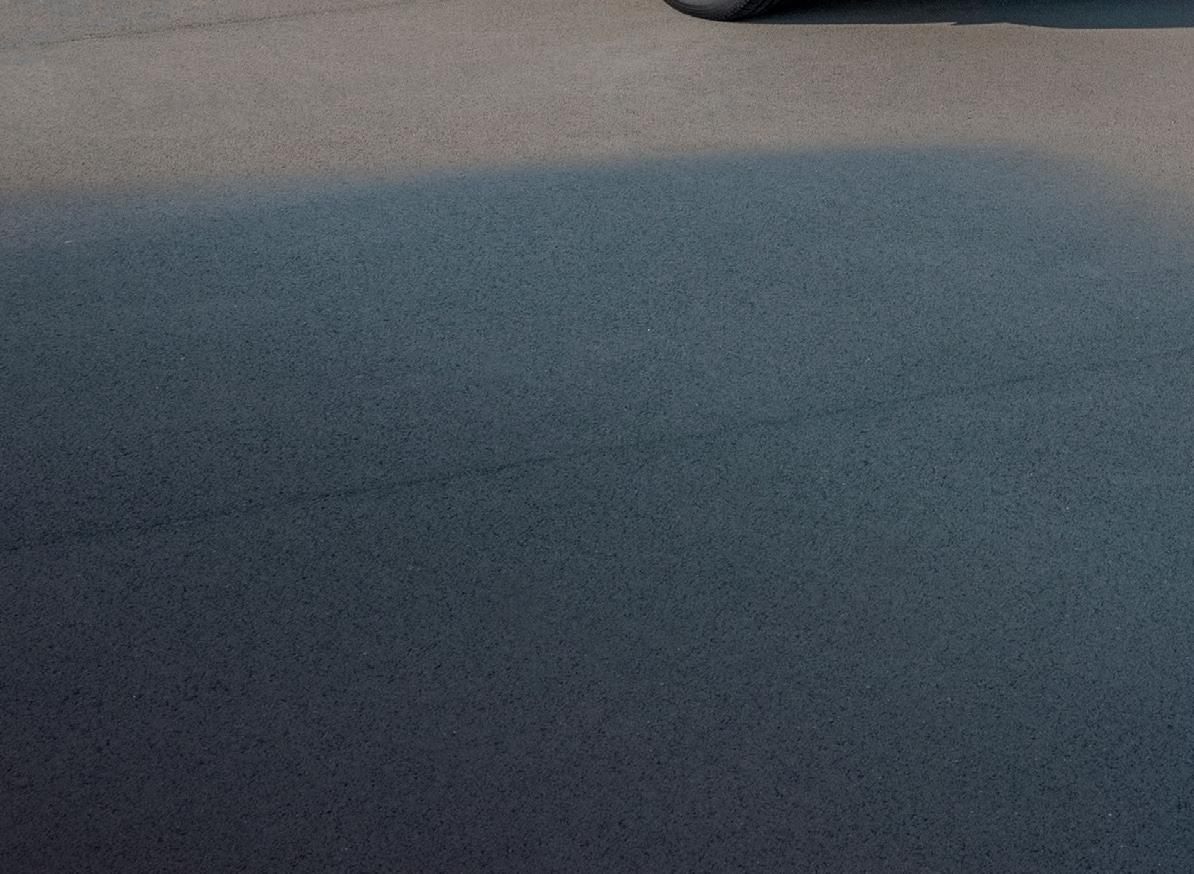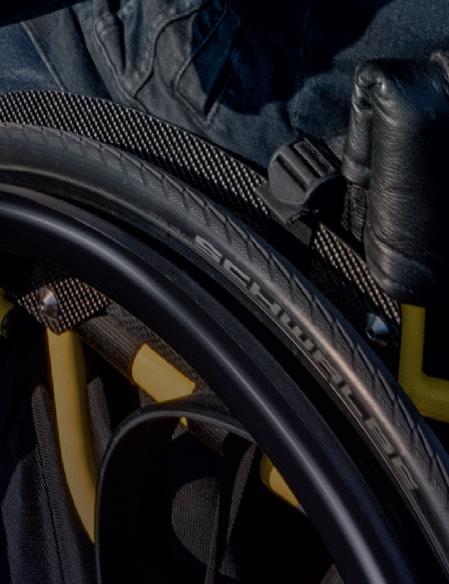

ONE MAN AND HIS DUCK
How a soft toy sparked a global conversation about men’s mental health
BE MONEY WISE THIS WINTER
Our top tips
YOUNG CARERS
One young woman shares her story

Ed Jackson and Luke Tarrant on rewriting what it means to explore





How a soft toy sparked a global conversation about men’s mental health
Our top tips
One young woman shares her story

Ed Jackson and Luke Tarrant on rewriting what it means to explore



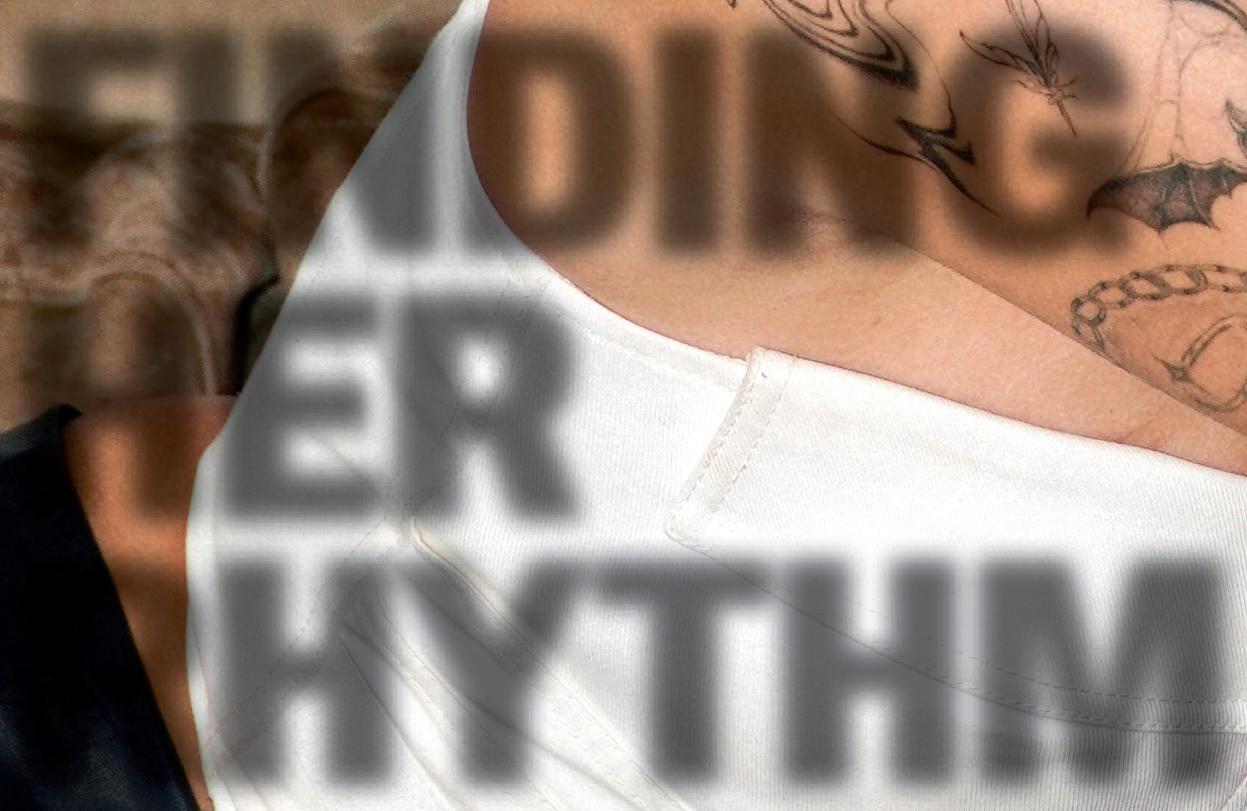
Singer Talia Mar reflects on the challenges of being an autistic first-time mum
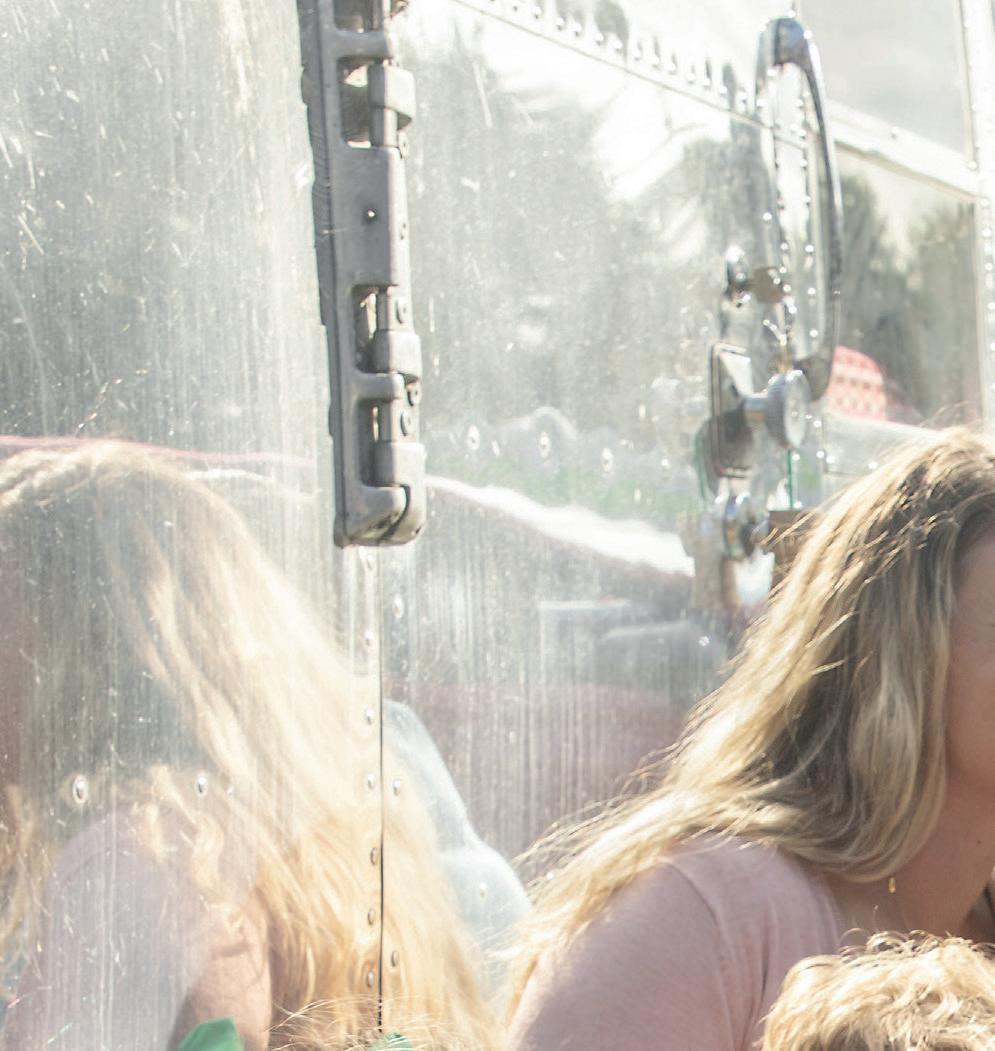







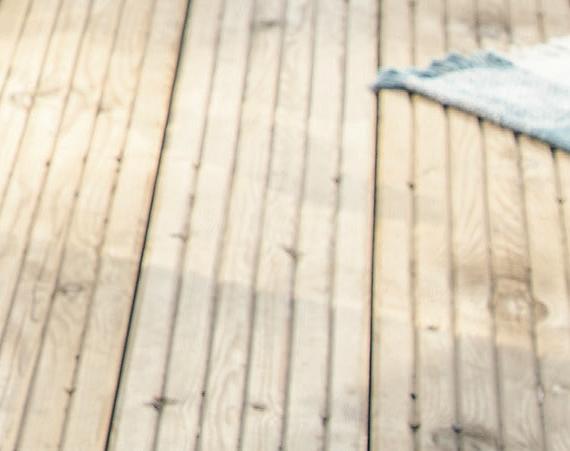


COVER PRICE £3.00
PUBLISHER
Denise Connelly denise@dcpublishing.co.uk
EDITOR
Melissa Holmes melissa.holmes@dcpublishing.co.uk
STAFF WRITER
Kate Stevenson kate.stevenson@dcpublishing.co.uk
EDITORIAL CONTRIBUTORS
Jane Hatton
Samantha Renke
Tim Rushby-Smith Alisdair Suttie
DESIGN AND PRODUCTION
Lucy Baillie lucy.baillie@dcpublishing.co.uk
SALES
Marian Mathieson marian.mathieson@dcpublishing.co.uk
ENABLE MAGAZINE www.enablemagazine.co.uk
DC Publishing Ltd,
198 Bath Street, Glasgow, G2 4HG
Tel: 0844 249 9007

t’s a warm welcome to this wintry edition of Enable magazine. As always, it’s packed with great articles. With more than 2.2 million followers across social media, Talia Mar is the autistic musician who needs no introduction. For this issue, Talia sat down with our brilliant young writer Kate Stevenson to share her feelings around the latest chapter in her life. Read about Talia’s experiences of first-time motherhood as an autistic woman on page eight.
You’ll find more great interviews within these pages, from young carer Fliss talking about her experiences of looking after her mum, to tennis star Ruby Bishop chatting about her campaign to make PE lessons more inclusive. Be inspired by an epic attempt to climb one of the most remote mountains in the world (which didn’t go as planned), or be cheered by stories of people whose hobbies have led to new friendships and greater acceptance of their disability.
In terms of health, we learn more about chronic fatigue and the impact it has, discuss the links between weight loss injections, diabetes and dementia, and look at how disabled young people can access good dental care.
We couldn’t let this issue go by without at least some festive features, whether that’s our focus on loneliness at Christmas, or our gift guide bursting with products from disabled business owners. On that note, I’ll take this opportunity to send you my hopes and wishes for a peaceful Christmas and positive New Year. I’ll see you in 2026!

42
Broadcaster and advocate
Sophie Morgan chats about working with high street giants Primark to create a wheelchair-using mannequin; something she’s dreamed about for two decades.
53
THIS
Our top tips to help you make sensible savings this festive season.


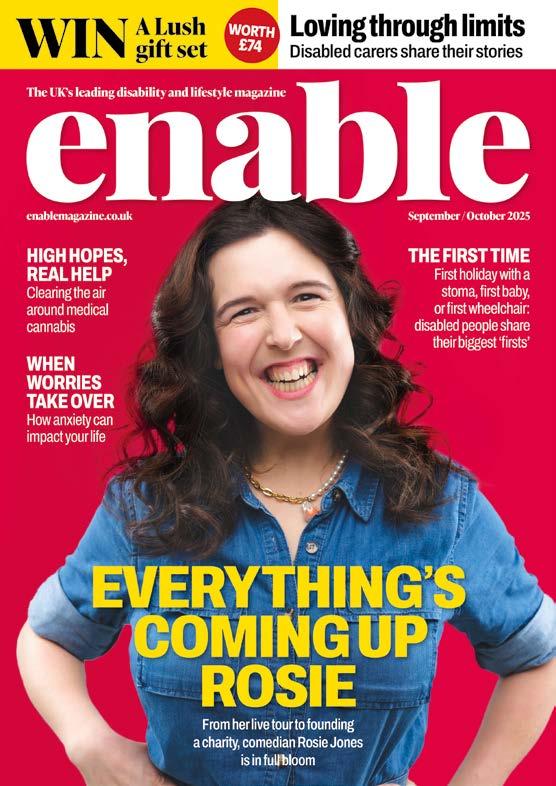

08 TALIA MAR: FINDING HER RHYTHM
The singer speaks exclusively to Kate Stevenson about the challenges and strengths of being an autistic firsttime mum.
10 BOLD AND BEAUTIFUL
Part fashionista, part activist, Roxanne Murray is rewriting the rules of disability and beauty. We learn more.
15 ONE MAN AND HIS DUCK
Sid Batty on how his stuffed toy duck has sparked a global conversation about men’s mental health.
38 THE MOUNTAINS WE CLIMB
Adventurers Ed Jackson and Luke Tarrant chat about their mission to scale one of the most remote peaks in the world in this exclusive interview.
42 SITTING PRETTY: A MANNEQUIN NAMED SOPHIE
Broadcaster and activist Sophie Morgan discusses how her decadeslong dream of seeing a wheelchairusing mannequin on the high street is finally a reality.
66 MORE THAN JUST A MATCH
Why are so many disabled kids left out of PE lessons? Tennis star Ruby Bishop wants to change that.
36 ACCESS INTIMACY
Samantha Renke on the realisation of who she can really trust when it comes to supporting her access needs.
50 BEST FOOT FORWARD
Tim Rushby-Smith questions why so much importance is placed on being able to walk again when you’ve experienced spinal cord injury.

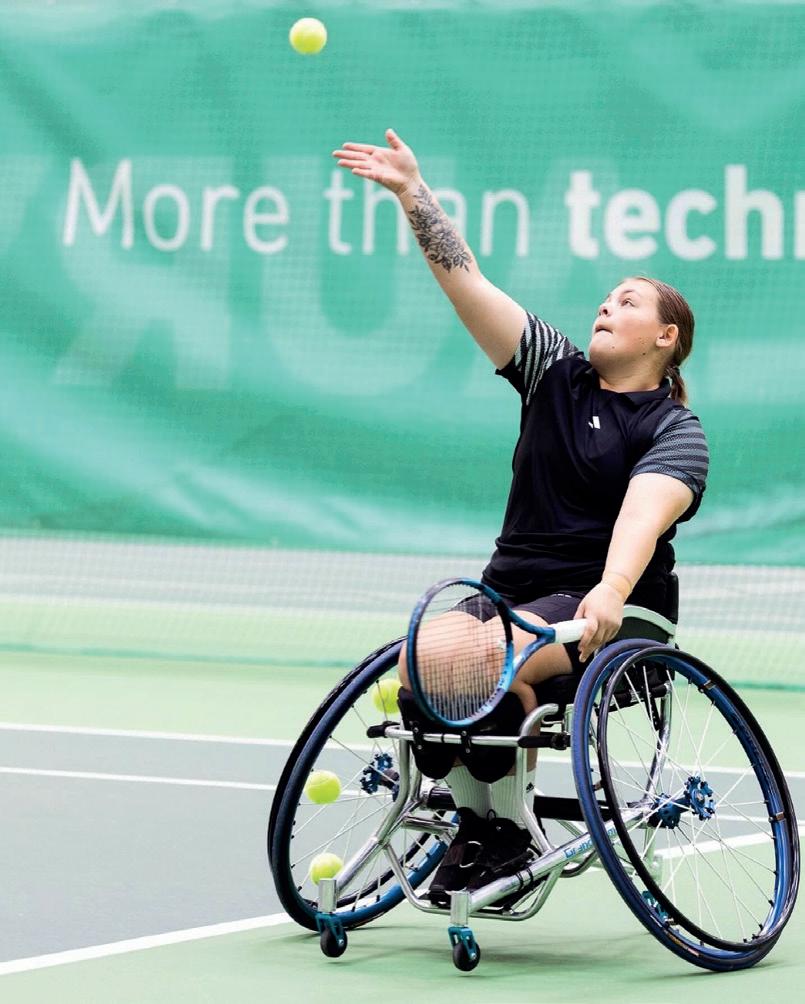

25 NOT SO MERRY?
Whether you’re dreading the festive fuss, or preparing yourself for another lonely silent night, we learn how to make Christmas more manageable.
29 OUT AND ABOUT
Have a jolly Christmas with our selection of accessible festive events across the UK.
30 CHRISTMAS GIFT GUIDE
Our Editor’s favourite picks for the festive season, mostly from disabledled businesses.
33 A GATEWAY TO A WHOLE NEW LIFE
With more of us opting to stay home in the cold weather, perhaps it’s time to think about getting a new hobby? We discover more.
48 NO PLACE TO CALL HOME
Homelessness is on the rise amongst disabled people. Enable investigates the causes, and the support available.
18 A SHOT AT BETTER HEALTH?
Weight loss injections are the health trend that’s hitting the headlines, but are they safe if you’re disabled? And what’s their link to dementia?
20 BEYOND TIRED
Chronic Fatigue Syndrome is more than just being tired. Isabelle Pearcey talks about living with the condition.
23 KEEP WELL THIS WINTER
As the nights draw in and temperatures drop, we all want to stay home and hibernate. But keeping active during the winter months is vital to protect your overall wellbeing.
45 THE WHOLE TOOTH
From long waiting times to inaccessible premises, dentistry student Molly Connelly reflects on how children with additional support needs can access quality dental care.
12 SOME DAYS ARE BETTER THAN OTHERS
Taking on the responsibility of caring for a loved one can happen to anyone, at any age. Young carer Fliss shares her story with our Editor.


56 JAECOO 7
Striking looks mark out the Jaecoo J7 in a hotly contested sector, but does the drive match the style? Our motoring expert checks out the brand’s latest model.
53 BE MONEY WISE THIS WINTER
From moneysaving hacks to lifestyle changes, we investigate the most effective ways to reduce spending at this expensive time of year.
59 EMPLOYMENT Q&A
Our careers expert Jane Hatton answers a reader’s question about working from home.
60 AN INCLUSIVE OPTION?
How home education can offer a viable alternative for children who struggle in school environments.
63 BARRIERS TO WORK?
Barely a generation ago, finding and keeping a job as a disabled person was challenging. How are things changing?
GUIDE DOGS IS CELEBRATING the arrival of its largest litter for three years – a whopping 13 puppies, affectionately known as ‘the Baker’s Dozen’. Mum Yori, a Golden Retriever-Labrador cross, welcomed them at home in August. The puppies are now ready to head off to volunteer Puppy Raisers around the UK and rise to the challenge of becoming life-changing guide dogs in 2027.
The 13 pups have bakery-themed

names: the boys are Biscuit, Crumble, Bagel, Crumpet, Rye, Tiger and Pretzel, and the girls are Apple, Eccles, Cocoa, Chelsea, Custard and Ginger.
Janine Dixon, Breeding and Welfare Operations Lead at Guide Dogs, said: “Each pup has a bright future, hopefully becoming a guide dog bringing independence and mobility to someone with sight loss.” guidedogs.org.uk/guidedogs-appeal
A WHITE PAPER, DETAILING a muchneeded overhaul of special needs education in England, has been delayed until the new year as the Department for Education seeks views from key parent and expert groups. The White Paper was expected to include proposals around changing funding and treatment, highlighting the need for early, local, evidence-based, and well-funded interventions.
Tom Rees, chair of the government’s expert advisory group on SEND, said: “Reforming the SEND system is both the most important and the most complex policy area in education today. There is lots of appetite for change and it’s important to take the time to get this right.”

PRESIDENT TRUMP HAS CAUSED global outrage with his recent comments around autism. He stated there has been a “meteoric rise” in diagnoses of autism in the US, claiming paracetamol use during pregnancy is the cause, and warning women not to use the common treatment. UK Health Secretary Wes Streeting rejected the unproven claims, while Mel Merritt of the National Autistic Society said: “Trump’s claims about autism are dangerous, anti-science, and irresponsible, and lead to judgement and harm towards autistic people and their families.” In response to the unfounded remarks, the charity launched its Truth. It Matters campaign at autism.org.uk/ truth, attracting 10,000 signatures in the first 24 hours.
RESEARCH HAS FOUND THAT a diabetes drug used together with antihistamine could repair Multiple Sclerosis damage. The study, by the University of Cambridge and funded by The MS Society, has discovered a combination of diabetes drug metformin and the antihistamine clemastine can help repair myelin – the protective coating around nerves, which gets damaged in MS. Leader of the trial Dr Nick Cunniffe explained: “My instinct is that we are on the brink of a new class of treatments to stop MS progression, and within the next decade we could see the first licensed treatment that repairs myelin and improves the lives of people living with MS.”
Are you receiving Income-related Employment and Support Allowance?

It’s not automatic, so look out for your letter telling you what to do. Visit gov.uk/ucmove for more information.
Singer-songwriter Talia Mar is finding her truest rhythm in the quiet moments of motherhood. She speaks exclusively to Kate Stevenson about being an autistic first-time mum
The Zoom call flickers to life, and Talia Mar appears with the unmistakable glow of new motherhood: exhaustion in her eyes but joy in her smile. Although she describes herself as “a bit dramatic”, she doesn’t dress anything up during our interview. Not the realities of pregnancy, not the sleepless nights, and certainly not the challenges of motherhood as an autistic woman. “I’m blunt, but I’m honest!” she says, smiling.
Fans have always known Talia, now 28, as the powerhouse singer-songwriter, Twitch streamer, and YouTube creator. But beneath her confident stage persona, a quiet doubt lingered: why did the world feel different for her? Why did she process things so intensely?
It wasn’t until adulthood that Talia received her autism diagnosis: a revelation that, in her words, has made her “more forgiving” of herself. “I’d always felt different,” she explains. “When I got my diagnosis, I thought, ‘Oh, this makes sense’. It didn’t feel scary, it was relieving. I could stop blaming myself for being too much, or for finding things harder than other people.”
That self-understanding has come into play recently, as Talia and her husband Simon welcomed their baby daughter in July. “Motherhood has been a whirlwind,” she admits, recognising that her neurodivergence has influenced her journey. “It’s the most incredible thing, but also the hardest. I’d be doing it a disservice if I said otherwise.”
Talia particularly struggles with sensory challenges, and finds that sharp cries can be overwhelming. Noisecancelling headphones have become her lifeline, and the steady hum of the baby’s white noise machine comforts Talia too. “It regulates me,” she clarifies. “It gives me something to tune into, so I’m not so overwhelmed.”
She’s even developed her own grounding technique: rhythmically tapping her daughter’s back to help her focus. “It’s almost like using a fidget spinner, but it’s my baby,” she laughs again. “She loves it too!”
And, while parenthood has no manual, Talia has discovered that her neurodivergence offers surprising strengths: “A friend told me she gets stressed when her baby cries for no reason. It confused me because everything has a reason. I create a logical scenario in my head: maybe she’s got a tummy ache, or a headache – that’s why she’s upset.” It’s a form of systemising – giving every cry a reason –that offers Talia the cognitive closure she needs, and now it helps her friend too.
Talia has always been open about her life, and sharing her ASD diagnosis online felt right. It’s helped her challenge misconceptions and, right now, she’s proving that autistic people can be parents too. “The stereotype is that autistic people won’t cope, that it’ll be too much.” She shakes her head: “That’s not the reality.” Talia says autistic people can find ways around the challenges –just like everything else: “If noise is hard, get headphones. If touch is difficult, use gloves,” she suggests. “Think it through, then go for it. You’ll work it out.”
One of Talia’s biggest struggles is structure. It’s always been important for her but, in the past year, it’s taken on a new meaning: “I’ve had to reprogramme what routine means to me. My new routine is waking up and not knowing what the day will bring. I’ve trained my brain to expect the unexpected.”
Talia might look like she has it all together, but she admits being pregnant was far from easy. She suffered from hyperemesis gravidarum, a form of extreme sickness that lasted for months. Thankfully, her birth experience – via a planned induction – gave her the
structure she craved: “I had a plan and, luckily, it went smoothly. That was such a blessing for me,” she reveals.
She’s also grateful for her husband, who’s been her anchor through it all. “I salute single parents,” acknowledges Talia, her voice softening. “I don’t know how people do it without support. Having someone there who I can cry to, and who listens to me when I’m overwhelmed, has been a gamechanger.”
The couple’s approach to parenting is evolving, and they’re figuring it out as they go. “Some weeks she naps, some weeks she doesn’t, which can be more intense. Right now, our lives revolve around her. We’re just treading water until she finds her rhythm.”
And, as public figures (Talia has 2.2 million followers across TikTok and Instagram, while Simon is a very popular YouTuber), they’re both extra careful when it comes to their daughter’s privacy. “I’ll share my experiences – my pregnancy, my struggles – but I don’t want to share hers. I want her to have the choice one day about what’s out there.”
Like all mums, Talia has high hopes for her daughter’s future. “I want her to find what she loves,” she smiles, a twinkle in her eyes whenever she talks about Juni. “To have the courage to try things, and to discover the things that make her truly happy. That’s all I want.”
It’s hard to imagine that Talia used to sit alone in the music cupboard at school, writing songs and feeling out of place. Now, she has a successful career, is surrounded by people who love her, and is thriving as a new mother. As she tells me: “Things will all make sense when you’re older.”

When I got my diagnosis, I thought, ‘Oh, this makes sense’
Part fashionista, part activist, Roxanne Murray is turning style into self-expression and advocacy. She tells us more about how she’s rewriting the rules of disability and beauty
When stylist and podcaster Roxanne Murray struts into a room, she makes sure her cane matches her outfit. @multiplesclerosisfashionista, as she’s known online, is bold, beautiful, and not afraid to use her wardrobe and words to challenge how the world sees disability.
“When I first used a cane, I felt like I’d lost a lot of who I was,” she reveals. “Now it’s an extension of my personality.” For Roxanne, fashion isn’t vanity: it’s visibility. Every outfit, nail set and mobility aid is a statement. She exists loudly – and on her own terms.
Roxanne’s quick to admit that her own empowerment didn’t come easily. No, it came after years of medical mistreatment. “They didn’t think Black people really got MS,” she says, shaking her head. “It was seen as a white woman’s disease.”
As a result, she was misdiagnosed with lupus for eight years, and went without treatment during the critical early phase of her illness: “But it lit the fire under me,” remembers Roxanne. “I didn’t want anyone else – especially someone young, brown, disabled or queer – to go through what I did.”
That drive shaped everything that followed next. Through her podcast – titled Sick and Sickening – as well as her writing and activism, Roxanne pushes for better healthcare equity. She wants to see improved representation of the diversity that exists among disabled people: “People of colour are often not seen in the community,” she says. “We need to change that.”
While her advocacy is serious, her style is pure joy.
On Instagram, Roxanne’s outfits burst with colour and attitude: “Adaptable fashion didn’t match my taste,” she says. “I wanted it to be more flamboyant, more me.” Now she collaborates with mobility aid brands, and uses fashion as a way to express her power, beauty and self-worth.

And she’s outspoken about sexuality and body confidence too. Roxanne isn’t afraid to tackle topics that mainstream disability narratives often avoid. “We’re disabled, not dead,” she laughs. “Sexual pleasure is part of wellness.”
But behind the glitz and the glamour, there’s a lot of grit. Living with MS means she’s had to adjust. “A lot of things about myself have changed,” admits Roxanne. “It took me a while to understand that there’s beauty in that, and who I’ve become.”
When the going gets tough, she turns back to fashion: “People think fashion is frivolous,” she smiles. “But it’s how I take control when everything else feels unpredictable.”
People think fashion is frivolous. But it’s how I take control when life feels unpredictable

As temperatures fall and weather conditions deteriorate, National Highways is reminding drivers to check their vehicle ahead of any long journey. Taking time to inspect your car all year round is essential, especially during the colder months, not only to help you to stay safe on the roads, but also to prevent avoidable breakdowns.
Tyre safety becomes especially important as road conditions get colder and wetter. Worn, under-inflated or damaged tyres are far more likely to cause collisions or breakdowns. In fact, tyre issues were the leading cause of breakdowns on the UK’s motorways and major A-roads in 2024, with more than 53,000 incidents –almost a fifth of the total incidents recorded by our traffic officers.
National Highways and Kwik Fit are reminding drivers of the T.R.I.P. acronym – a simple guide to help prepare for long journeys:
• Top-up: Check essential fluids like oil, screen wash, and coolant
• Rest: Take breaks every two hours to stay alert and avoid fatigue
• Inspect: Check tyres, lights, and wipers before setting off
• Prepare: Check the weather forecast and your route in advance of setting off
We understand that some customers with accessibility or mobility needs may face unique challenges while carrying out T.R.I.P. checks. That’s why we’re partnering with Kwik Fit to check your vehicle for you and help you stay safer on your journey.
National Highways is highlighting that Kwik Fit can ensure T.R.I.P. checks are more accessible via their services, offering free vehicle checks at garages. They also offer tyre fitting at home via their mobile service if more convenient for customers.
Colin Stevenson, Road Safety Information Lead at National Highways said:
“We know that cars can be a lifeline for drivers with a disability, so ensuring they are prepared for any journey is important and helps to prevent avoidable breakdowns.
“We’re teaming up with Kwik Fit to help drivers who may not be able to carry out vehicle checks themselves with the offer of a free vehicle check. Each Kwik Fit vehicle check follows the T.R.I.P. checklist - including tyre inspections and ensuring your oil and screen wash are topped up.”
Please visit the T.R.I.P. campaign for more information: www.nationalhighways.co.uk/TRIP
To book a free vehicle health check and for more information on what Kwik Fit will check: https://www.kwik-fit.com/vehicle-safety-check

Being a carer is something we often associate with adults or older people, but taking on caring responsibilities for a loved one can happen to anyone, at any stage in life. Editor Melissa Holmes speaks to Fliss about life as a young carer
Being a carer is hard. From sleepless nights spent supporting a loved one in pain, to the physical challenges of helping with personal care, and the mental load of juggling appointment schedules, medication, and the weight of responsibility. It’s a lot for anyone to manage.
But, for the estimated one million young carers in the UK, there are extra burdens – not least missing out on school, time with friends, and ordinary childhood activities other young people take for granted. The effects of missed education, social isolation, anxiety and other issues continue into adulthood too – 48% of young adult carers feel their caring role has had a significant impact on their personal career progress.
In 2014, when Fliss was just eight, her mum became paralysed from the neck down in a car accident. With minimal ‘official’ support available, Fliss became a carer overnight. “Dad ended up losing his job, and I missed so much school they wanted to take us to court,” she explains.
Her experience is common: according to MYTIME Young Carers’ groundbreaking report Punished for Caring, young carers are more than twice as likely to face suspensions and exclusions as their peers, and almost half are persistently absent from secondary school.
Now 19, Fliss recently started a foundation course at university and hopes to become a product designer: “I want to see if I can help more
people who have tetraplegia like mum, or other mobility struggles,” she explains. But she’s still juggling university studies with caring, and told me: “I’m a bit behind because I’m still trying to care for mum – I’m living at home, but university is a 40 minute journey and I’m there every day from nine till five.”
Being a carer can involve all sorts of different tasks. For Fliss, it might mean getting food or drink, helping her mum into a hoist to use the toilet or shower, transferring her to her wheelchair, or changing an incopad. “It’s quite full-on,” she says – something of an understatement for a child to manage. “But it’s day dependent – some days are better than others.”
Like many young carers, Fliss had to grow up quickly when her mum was injured. Once her mum could leave the hospital for a few hours each day, Fliss and her dad were told they wouldn’t get any support with caring. “I stepped up,” says Fliss. She decided that her younger sister Olivia wouldn’t shoulder any caring responsibilities: “I said no, in no uncertain terms, because I wanted at least one of us to have some sort of normality – some sort of childhood.”
The impact of missing out on childhood activities, friendships and education still affects Fliss. “When I was younger, I couldn’t understand why,” she admits. “No one forced me to help – I fell into the role because of lack of support from the healthcare system. I knew if I didn’t, mum
wouldn’t be able to do things like going out with us.”
Describing the physical tasks of being a carer as “just something I have to do”, Fliss feels the mental load is the hardest part of being a young carer. “You’re always thinking ‘What if mum needs this? What if this happens?’. There are constant thought processes, over and over.”
Fliss is still trying to process what she went through as a child, but it’s difficult: “When you’re caring, you don’t have time to think of yourself.” She experiences a lot of guilt, explaining: “You don’t know where to place the anger. I’ve done a lot for my age, but I shouldn’t have had to do it.”
Fliss feels anger towards the adult care and hospital systems, as well as the government. “It’s hard to stomach,” she states.
Across the UK, carers centres, charities and organisations provide
Dad ended up losing his job, and I missed so much school they wanted to take us to court

support to young people like Fliss. However, many young carers may struggle to identify themselves as such, so don’t always know where to seek help, or even that help is available. In England, young carers are entitled to an assessment from their local authority, to identify extra support they may need.
Fliss has received support from MYTIME Young Carers, based in Dorset, which offers an Employability Programme, a Level Up programme,
and Making Memories days. Of the latter, she says: “We do different activities like ice skating. It’s really nice, just pretending to be a kid again. I was able to think of myself without feeling horrible for it.”
Through the charity, Fliss has had help with career support and creating a CV, and has been involved in the Youth Action Advisory Board, presented a report to the House of Commons about school exclusions of young carers, and helped change the Ofsted framework so young carers are now classed as a vulnerable group.
And, although it’s hard, Fliss is full of smiles when she reflects on the high points of being a young carer.
“It’s seeing that mum can do the things she wants to do. I’ve seen her at her worst, so knowing I’m helping her go out and be able to do something… It’s nice seeing her smile.”
With winter approaching, a power cut may cause difficulty for some. Preparing for an outage could make things easier. Read below to learn about how your electricity Distribution Network Operator (DNO) can support you this winter.
Power cuts don’t happen often, but it’s better to be ready
• Keep torches handy – don’t use candles
• Ensure you have a phone that works without power
• Use a battery powered radio to listen to the news
• Ensure a back-up plan is in place if you rely on medical equipment
• Keep blankets or warm clothing handy
• Save the power cut number, 105
• Join the Priority Services Register
You can join the register if you
• Have mobility or health conditions
• Are of pensionable age or over
• Use medical/mobility equipment
• Have children under five
• Have communication difficulties
• Have a mental health condition
• Need extra care temporarily
Benefits of joining the register

• You’ll receive a direct dial number for reporting power cuts
• Support and information (including updates on restoration times) during power cuts
• Advance notice of planned interruptions
• A password (agreed with you) if we need to visit you
• Referrals to trusted partners to provide free advice on energy efficiency, financial assistance and fire safety
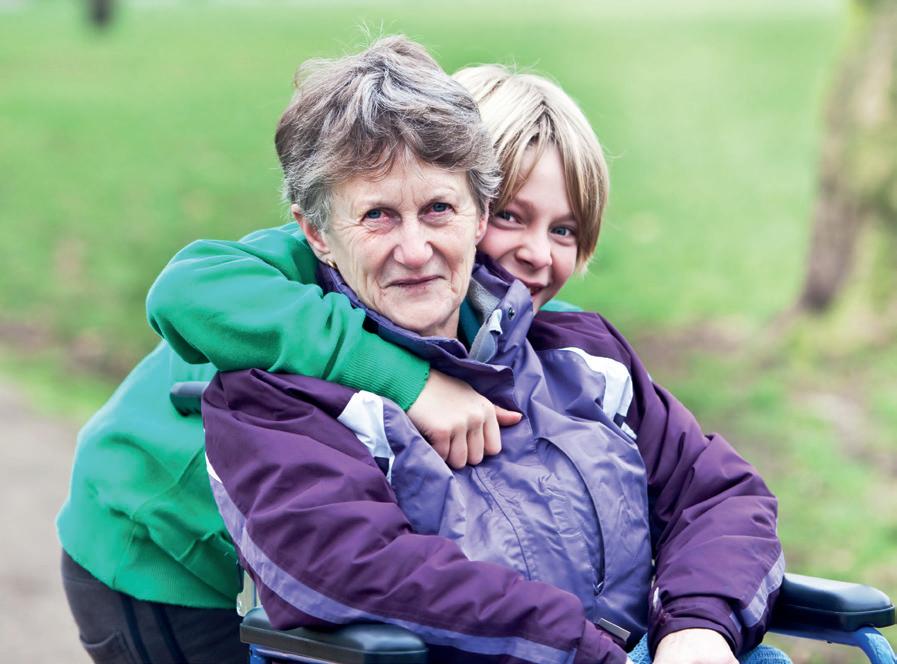
“One of our PSR customers was referred to our fuel poverty partner (as she was forced to choose between heating or eating) requesting help with a fuel and food voucher; the client’s gas meter was at an emergency credit status and the electric meter was also on its last pound.
The client had four young children and recently moved house. She was awarded a fuel voucher with a booster top up and we requested a food voucher.
The Social Supermarket criteria was explained so she could budget better and save money in future. A benefit check ensured the client was getting all the income she was eligible for. Local Council’s Household Support Fund assisted with white goods, bedding and furniture. The client was given energy-efficiency advice for grants etc. to keep her home warm.”
ThePSR.co.uk is a web page created to make adding your household to the Priority Services Register quick and easy, wherever you live. Go to www.ThePSR.co.uk, input a postcode and you will be redirected to the relevant DNO PSR page to sign up. It’s free to join and only takes a few minutes!
“My late wife was disabled, I phoned, and they said they knew about it then I got a text saying the power would be back on by 10:30pm it went off about 8:00pm. It was really easy to contact them every time.”

“The service was excellent. I had a call telling me when the power would be back on. The estimated time then changed but they let me know. The lady was lovely, very polite. I was well informed. They did a brilliant job.”









When life got tough, Sid Batty bought a stuffed duck named Quack to remind him that there was hope. He never imagined it would spark a global conversation about men’s mental health. He chats to Kate Stevenson about their journey so far

It was an ordinary day when Sid first decided to pull his small duck from his backpack and document their travels together. His plushie, named Quack, has now seen more of the world than most people, including Italy’s coastlines, the streets of Paris, and Silverstone’s F1 circuit. Wherever Sid goes, Quack goes too.
At first glance, it’s probably an unusual sight: a grown man photographing a plush toy perched on a ledge. But for Sid, Quack isn’t a gimmick: he’s helped the 24-year-old navigate some of the hardest moments of his life.
“It was about two or three years after I was first diagnosed with social anxiety, depression and OCD,” remembers Sid. “I’d just had knee surgery and was told
I couldn’t play football again. Football was my escape growing up. Then I went through a breakup, my degree got tough… and it felt like everything was crumbling.”
In the middle of that chaos, he walked into a shop and bought a stuffed duck. “I thought, ‘I’m going to buy something to symbolise a new start, a new hope. Whenever things get tough, I can look at him and remember why I got him.’”
At first, Quack sat quietly on Sid’s shelf. Then, a few years later, Sid decided to go solo travelling: “Growing up, I was always scared of being alone,” he explains. “I used to cry when I was on school trips. So, when I decided to go travelling after uni, I thought, ‘Why don’t I bring my stuffed animal with me? It’ll be like a piece of home on the go’.”
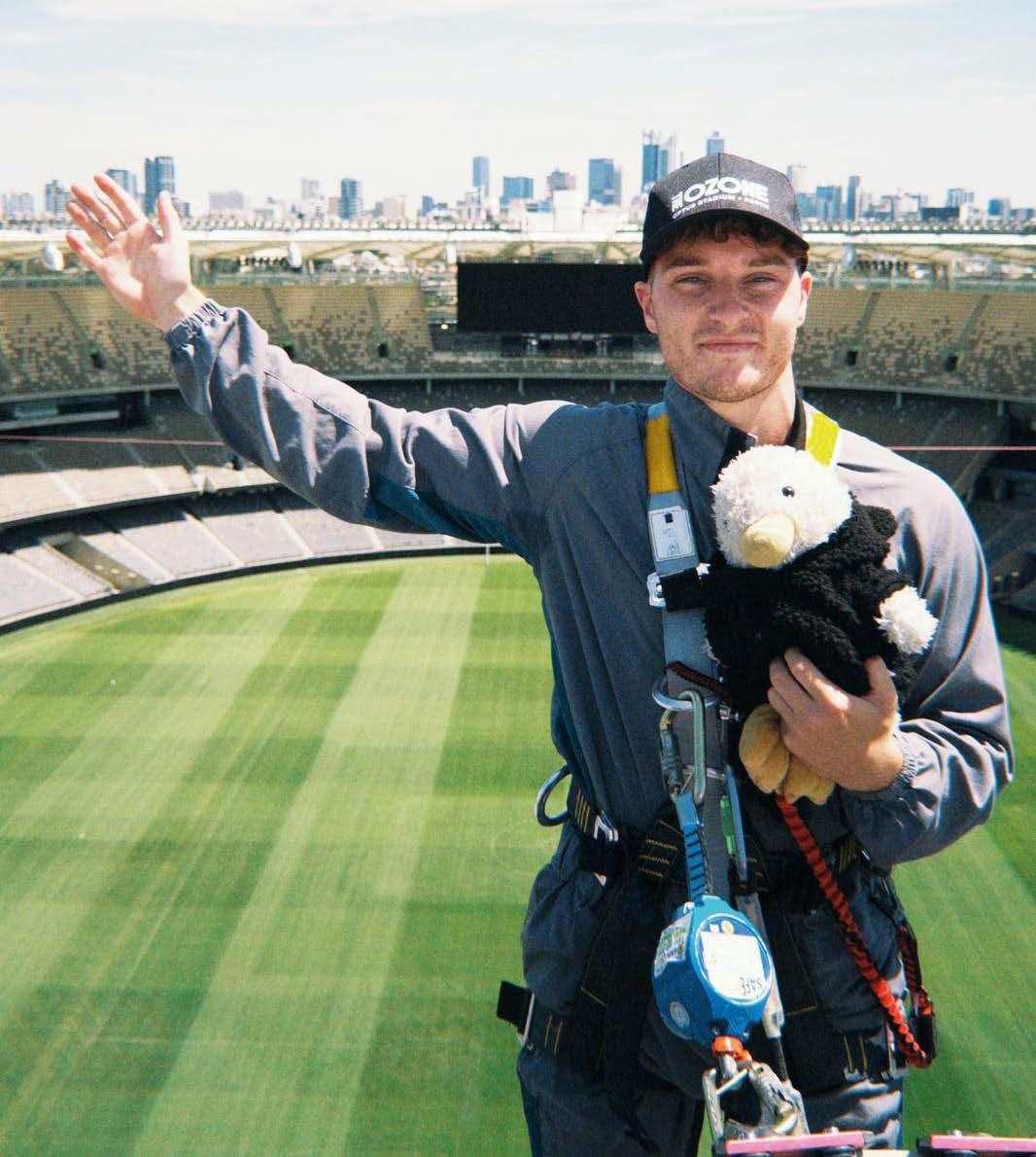
Slowly but surely, he began taking photos of Quack in every destination. They were only Polaroids at first but, over time, he made Instagram posts too. “Originally it was just for me and my family,” smiles Sid. “I never planned to go public. It was only for the memories.”
When he finally shared Quack’s story online, the reaction was instant. “Everyone was so overwhelmingly nice,” recalls Sid. “No one was looking down on me. They all just wanted to know more.”
Not every moment with Quack is as easy though: “When I was in
Sometimes people need a reminder that things will get better
Paris, getting a caricature done of us, I remember everyone staring. It was the first time I thought, ‘Ok, people are definitely judging me’.”
But he’s learned to let that go. “If I don’t know their name, why should their opinion bother me?” Sid says with a shrug. “I know what I’m doing and why I’m doing it.”
That attitude has become central to Sid’s message. His posts now reach hundreds of thousands of people, and his openness about anxiety, OCD, and self-doubt has made him an unexpected voice for men’s mental health. “It’s not about getting rid of mental health issues – yours or mine,” he reminds me. “It’s about managing them the best way you can.”
However, he admits that sharing his life so openly online sometimes brings its own pressure. “I still get anxiety every time I post something,” explains Sid. “The videos I make are either to help people, or to make them smile. So, when I’m having a bad day, I don’t want to share that. But then I think, ‘Ok, let me go do something I enjoy, and make a video out of that’.”

If you’re finding it hard to imagine the impact one man and his stuffed animal can have, this might sum it up: “A couple of months ago, a woman messaged me to say she’d booked her first solo trip after seeing my videos. She said she was bringing her daughter’s teddy with her daughter’s ashes inside – to show her the world.” Sid pauses. “That one made me cry. That’s when I realised this is bigger than me and my duck.”
Still, Sid accepts that he’ll always feel some judgment for being open about mental health, and for carrying a stuffed animal in public. “Once you accept you’re going to be judged, that’s half the issue,” he reasons. “The bigger problem is men feeling like they’re alone, which is just not true.”
“The thing is,” Sid continues, “I’m just a regular guy – I love football and going to the pub with my mates. But I also have this platform I can use to help other men. Because sometimes people need a reminder that things will get better.”
So, wherever Sid and Quack go next, you can be sure of one thing: they won’t just be taking photos. They’ll be reminding people across the world that hope can travel far.
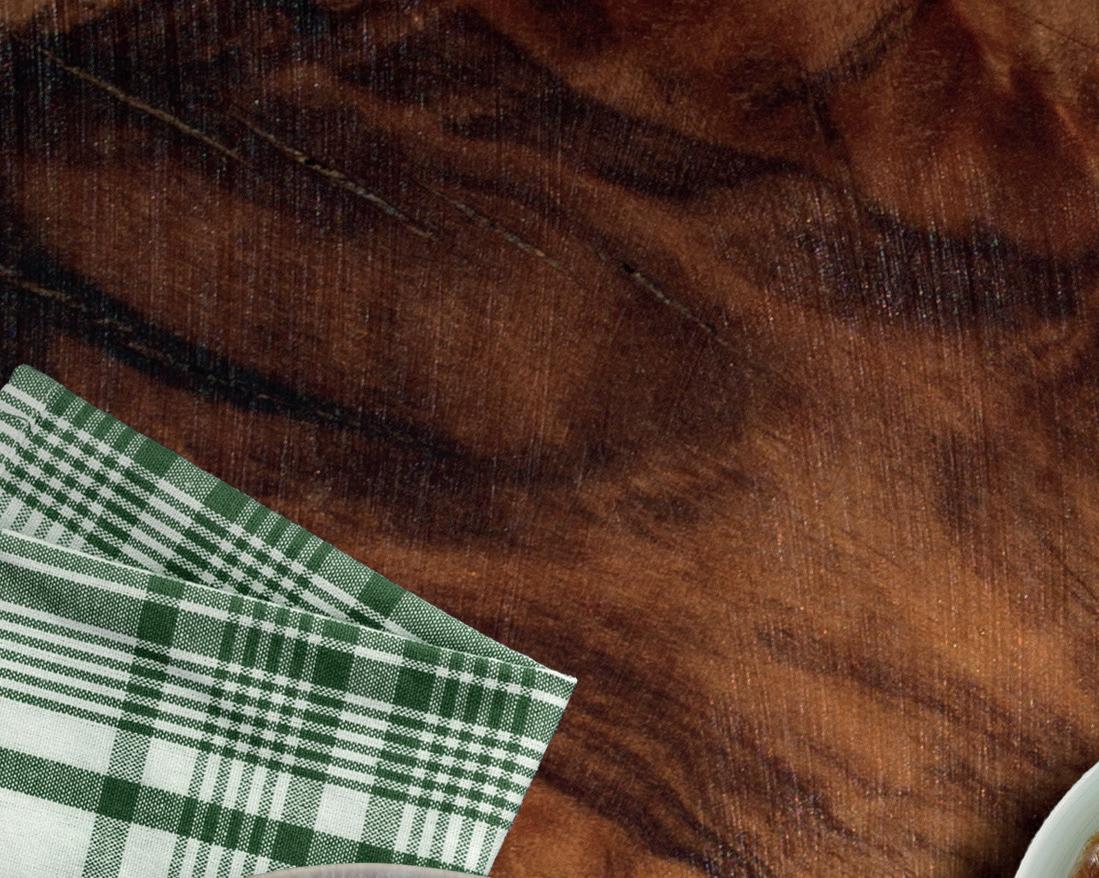

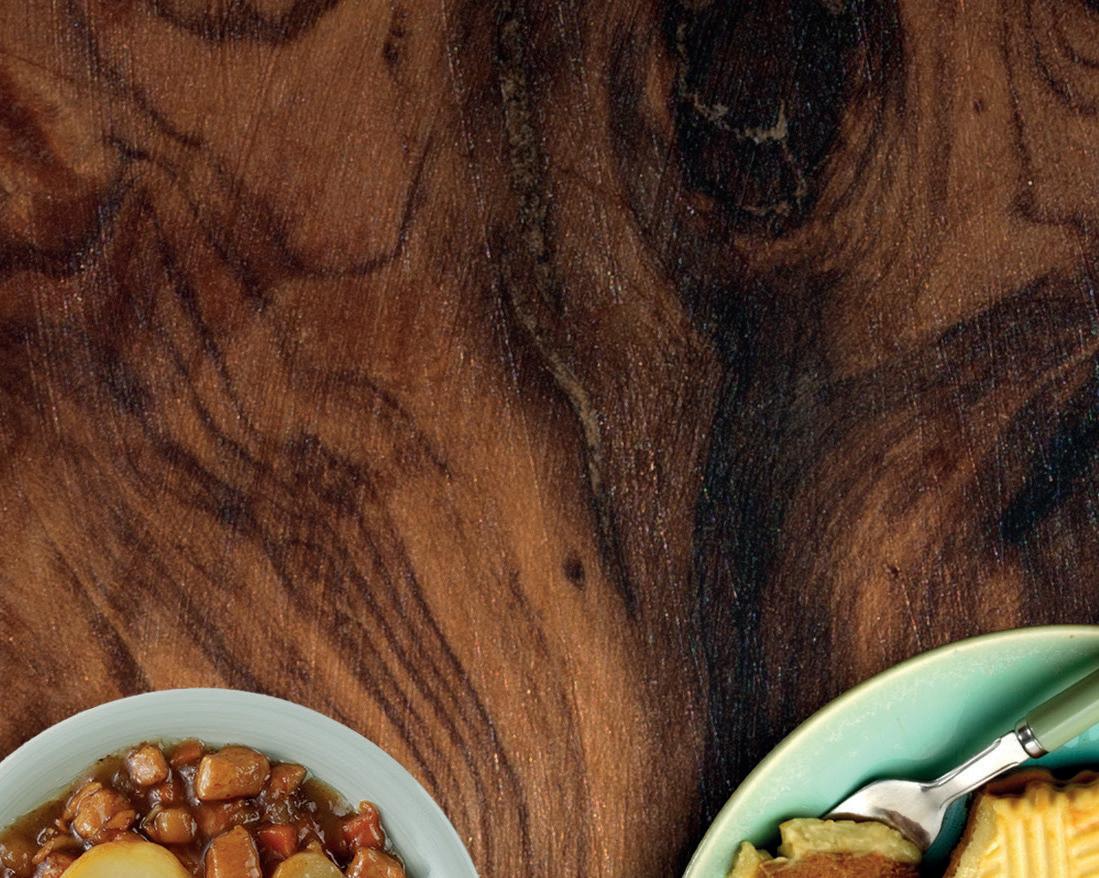

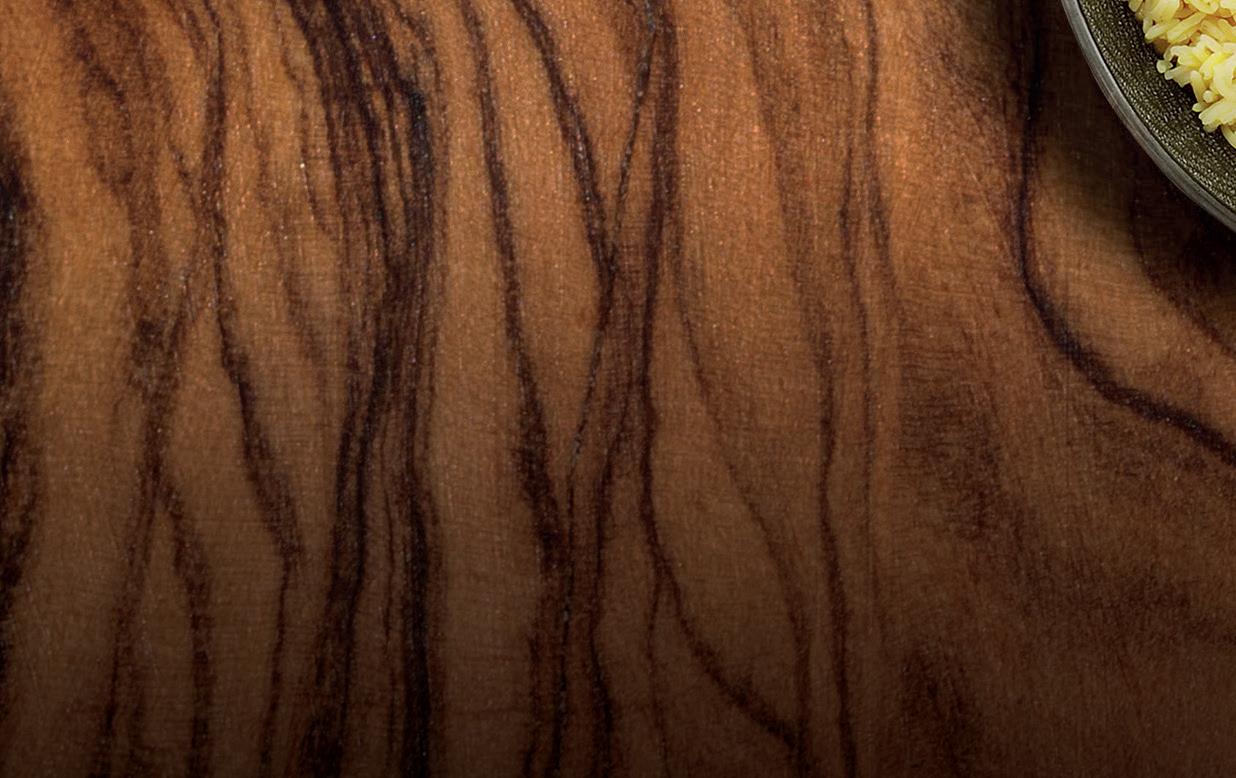




Weight loss injections are the health trend that’s hitting the headlines, but are they safe if you’re disabled? And could they even help prevent dementia? We investigate
Weight loss injections like Ozempic and Mounjaro have been all over the news, with users shedding an average of 22.5% of their body weight after 72 weeks of injecting Mounjaro, for example. One in four adults in the UK is living with obesity, which brings increased risks of type 2 diabetes, heart disease, cancers, and stroke. So, with obesity now a major health crisis, the potential for weight loss medication to change lives – and the entire healthcare system – is high.
POTENTIAL
There are even suggestions these drugs may play a role in protecting brain health and reducing the risk of dementia. Research is finding links between excess weight, type 2 diabetes and a higher risk of dementia in later life. According to Alzheimer’s Research UK, having type 2 diabetes can raise your
risk of dementia by up to 60%.
One of the ways to reduce the risk of developing type 2 diabetes is through maintaining a healthy weight. This can be a real struggle for many disabled people, who may be living with mobility challenges, pain, fatigue or the side effects of medication. And this is where weight loss injections may help to make a difference.
GLP-1 receptor medications like Mounjaro have been available for around 15 years to help diabetics regulate their blood sugar, but now they’re available through the NHS when specific criteria are met, and via private prescription.
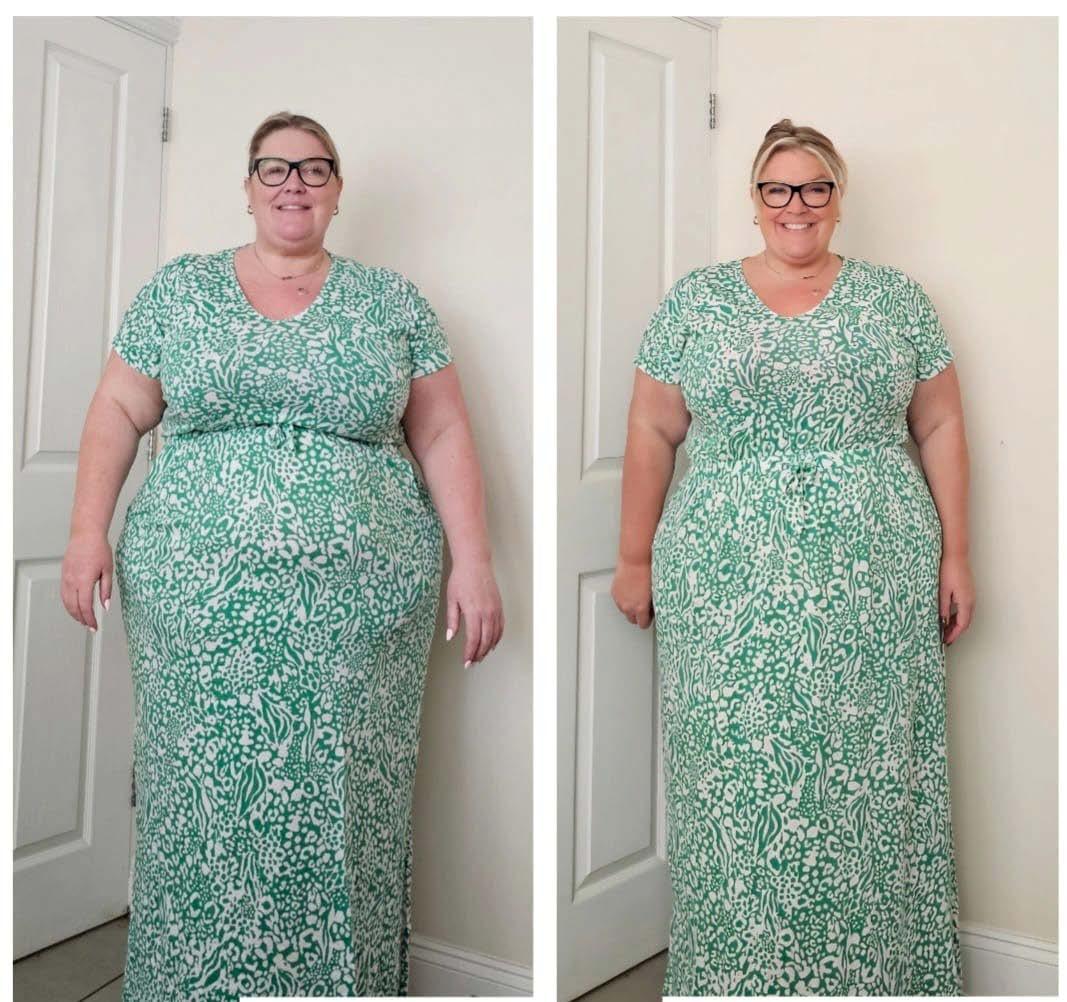
April 2025 September 2025
The drugs mimic a natural gut hormone which slows digestion, helps users feel full sooner, and can reduce cravings. Clinical studies have found they also improve blood sugar control and reduce cardiovascular risks, which could mean a lower risk of dementia – but scientists say it’s too early to know for sure.
However, the side effects can be hard to live with. Weekly selfadministered injections can lead to nausea, constipation and fatigue. They can also change how your body absorbs other medications. This is why it’s so important to discuss weight loss medication with your
doctor or specialist team, especially if you’re on multiple prescriptions.
Kerry Riches considered weight loss injections for months before taking the plunge and obtaining a private prescription. The MS Society Ambassador explains: “I really did my homework on this. I knew I needed to speak to my MS team, my GP, my family and even my management team – I was worried the medication may affect my work commitments if I was sick for a few days after injecting.”
Kerry’s main motivation for using weight loss medication was the increasing intensity of her MS symptoms. “I’ve got a real positive mindset, I’m on some amazing drugs. The only thing I hadn’t thought about doing was losing weight,” she explains. “But I was happy and confident. I was doing lots with the plus size community – I never looked in the mirror and thought I didn’t look nice.”
However, Kerry recalls trying to build Lego sets with her son and husband last Christmas, and realising her rings no longer fit her fingers and her fine motor skills were getting worse. She realised her weight was becoming a barrier to being healthy.
After researching her options, Kerry chose private prescriber myjuniper. co.uk, as they offer a package of
I don’t take any IBS medication now, and I’m not in pain when I wake up

support, including holistic care, a health coach, expert prescribers, and even a PT. Kerry understands the medication is about more than an injection, but actually about a lifestyle change and redefining her relationship with food.
“My BMI was over 50,” Kerry says. “I was a big girl.” Kerry has had IBS since she was a teen, and has spoken in the press about the impact it (combined with her MS) has had. “My bowel movements are now normal. That’s been massive, because it’s debilitating when you go somewhere and you’re frightened of soiling yourself. I don’t take any IBS medication now,” she reveals. “It blows my mind.”
Using weight loss injections is not without challenges – for Kerry, the medication took some getting used to. But her early side effects – Kerry
experienced nausea, headaches, and feeling colder – have passed now.
And, having lost four stones in five months, she’ll never look back. “The main thing is, I’m not in pain when I wake up,” she reveals. “After eight weeks of being on the jab, one morning I realised I hadn’t woken in the night with painful legs or feeling like my fingertips were going to burst.”
“I could never have lost that weight on my own. I like food too much, and the jab takes away that food noise,” she explains, referring to the temptation to eat all the time, given how easy and convenient it can be to obtain junk food. “It’s enhanced my life in ways I didn’t think were possible.”
Kerry’s story is inspiring, but everyone’s situation is different. What helps one person may not be right for another, especially when multiple health conditions are at play.
Weight loss injections can be transformative, but they’re certainly not a one-size-fits-all solution. For disabled people, potential benefits like improved mobility and increased energy must be weighed against side effects, accessibility, and the need for ongoing medical monitoring.
But one thing is clear: the research into the impact these drugs may have on other conditions, including their potential to protect long-term brain health, means they won’t stay out of the headlines for long.
Alzheimer’s Research: alzheimersresearchuk.org Alzheimer’s Society: alzheimers.org.uk Diabetes UK: diabetes.org.uk
Follow Kerry: instagram.com/kerryriches23
Chronic Fatigue Syndrome is about more than just being tired. Editor Melissa Holmes speaks to Isabelle Pearcey about living with the condition

Back in the 1980s, we cruelly called it “yuppie flu”. Mainly seeming to affect young, upwardly mobile professionals (“yuppies”), the mysterious illness was characterised by chronic tiredness, and what we’d call burnout today.
Now, we know better. This collection of symptoms – flu-like malaise, problems with sleep, brain fog, profound fatigue, headaches, nausea, joint pain, digestive problems, and sensitivity to light and sound – is understood to be Chronic Fatigue Syndrome, or ME (Myalgic Encephalomyelitis). The NHS and World Health Organisation recognise CFS/ ME as a post-viral fatigue syndrome and neurological condition. The classification also encompasses Long COVID, caused by the COVID-19 virus, which affects an estimated 1.8% of the UK population.
One of those people is Isabelle Pearcey, who contracted COVID-19 in 2021. “I had it for three weeks, thought I was better and went back to work,” explains Isabelle, who worked for a charity at the time. “I managed two days then I was literally bed bound, unable to move my head off the pillow.” She had a telephone consultation with her GP: “They said ‘We think it’s something we’re calling Long COVID, as you haven’t really recovered since having COVID’. They couldn’t help,” she shrugs.
“I was so ill, nothing made sense,” admits Isabelle. “I had cognition problems, so I couldn’t even take the
I was so ill, I couldn’t even take the diagnosis on board
diagnosis on board.” At the time, it was a case of getting through each day. She’d gone from working hard in her role and being a busy mum of two, to barely being able to move for 18 months. “To have all that suddenly taken away from me was a real mind bend,” she says.
Online communities of people with Long COVID provided some support. A positive mindset helped too: “Every day I woke up and, although I couldn’t lift my head off the pillow, I told myself ‘You’ll be better tomorrow’. The more you say that, the more you believe it.”
Adjusting her life and her expectations of what she can achieve has been challenging, but Isabelle’s making it work. She launched her business as an online business manager and virtual assistant in 2023 (izzwhizzva.co.uk) and, when she can manage it, her self-

care now consists of yoga and sound baths – quite different to the hours of daily weight training she did before developing Long COVID. Adapting to what life is like with CFS/ME is often the hardest part for many people. Isabelle suggests: “Always take longer than you think you need in your recovery phases. Without any current cure or treatment, that’s the best thing you can do.”
It can also be difficult to deal with other people’s expectations. Because Isabelle looks and acts well on her good days, people often assume she is fully recovered. “That’s the whole thing about an invisible disability, isn’t it?” She reflects, “It’s always present, but you get on with life and make the best of it.”




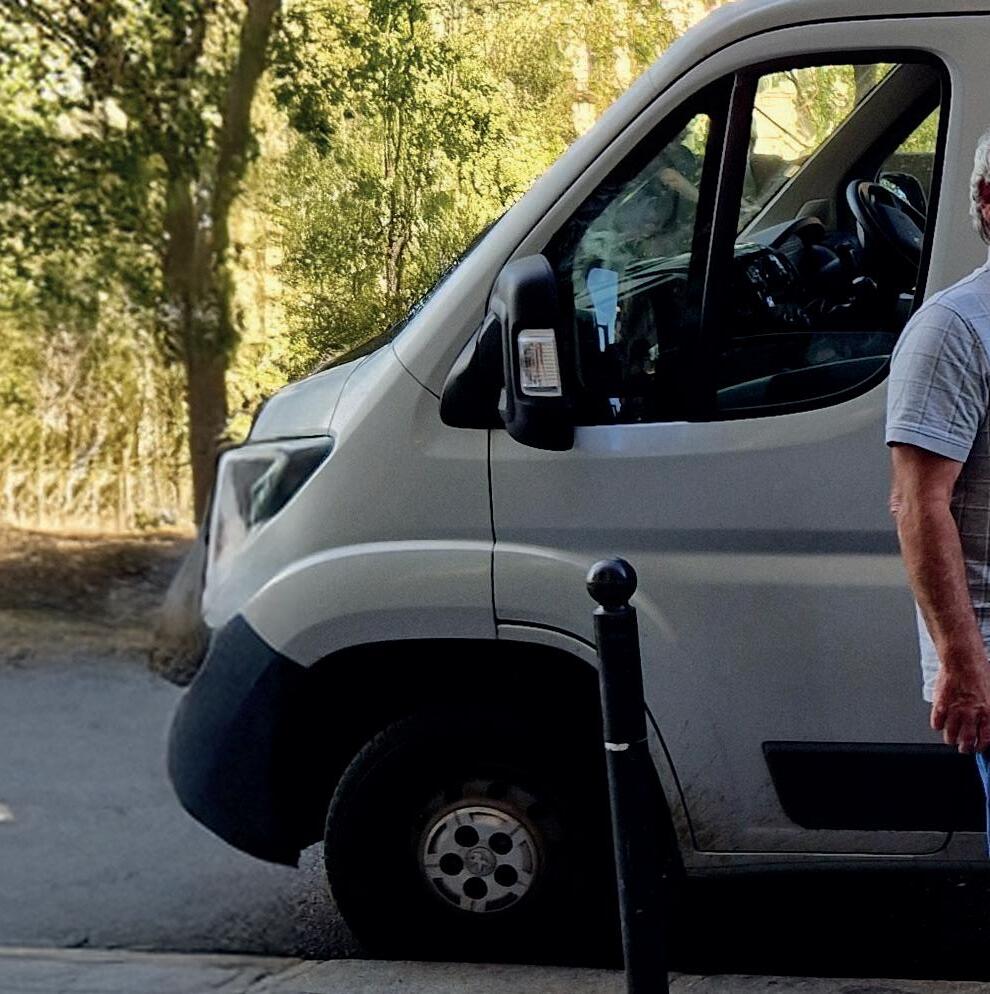

Mobility on your terms.
• Cheaper than daily hire if you need a WAV for weeks or months.
• More flexible than leasing, no years of commitment or large deposits.
• We help you find the right WAV for your needs….Flexible terms — swap, pause or cancel easily if your situation changes.
• Waiting months for your Motability car
• Not eligible for Motability but still need a WAV
• Without a vehicle while yours is being repaired
• Managing fluctuating health needs and want flexibility ORA keeps you moving - whatever life throws your way.
ORA’s subscription meant we weren’t stuck at home — even when our WAV was in the garage.
Mark, carer from Birmingham
Most people spend £1,200+ a month on taxis or tens of thousands buying a WAV. With ORA, you get the same freedom from £750/month, all-inclusive and flexible.

Audio Described
Captioned
Chilled Performance
Handheld Captioned
Performance with Integrated BSL interpreter

Audio Described
Handheld Captioned
Chilled Performance
Captioned
Performance with Integrated BSL interpreter Relaxed Performance

Audio Described
Captioned
Chilled Performance

Chilled Performance
Captioned
Audio Described
Handheld Captioned
Performance with Integrated BSL interpreter

Captioned
Audio Described
Chilled Performance CHILL
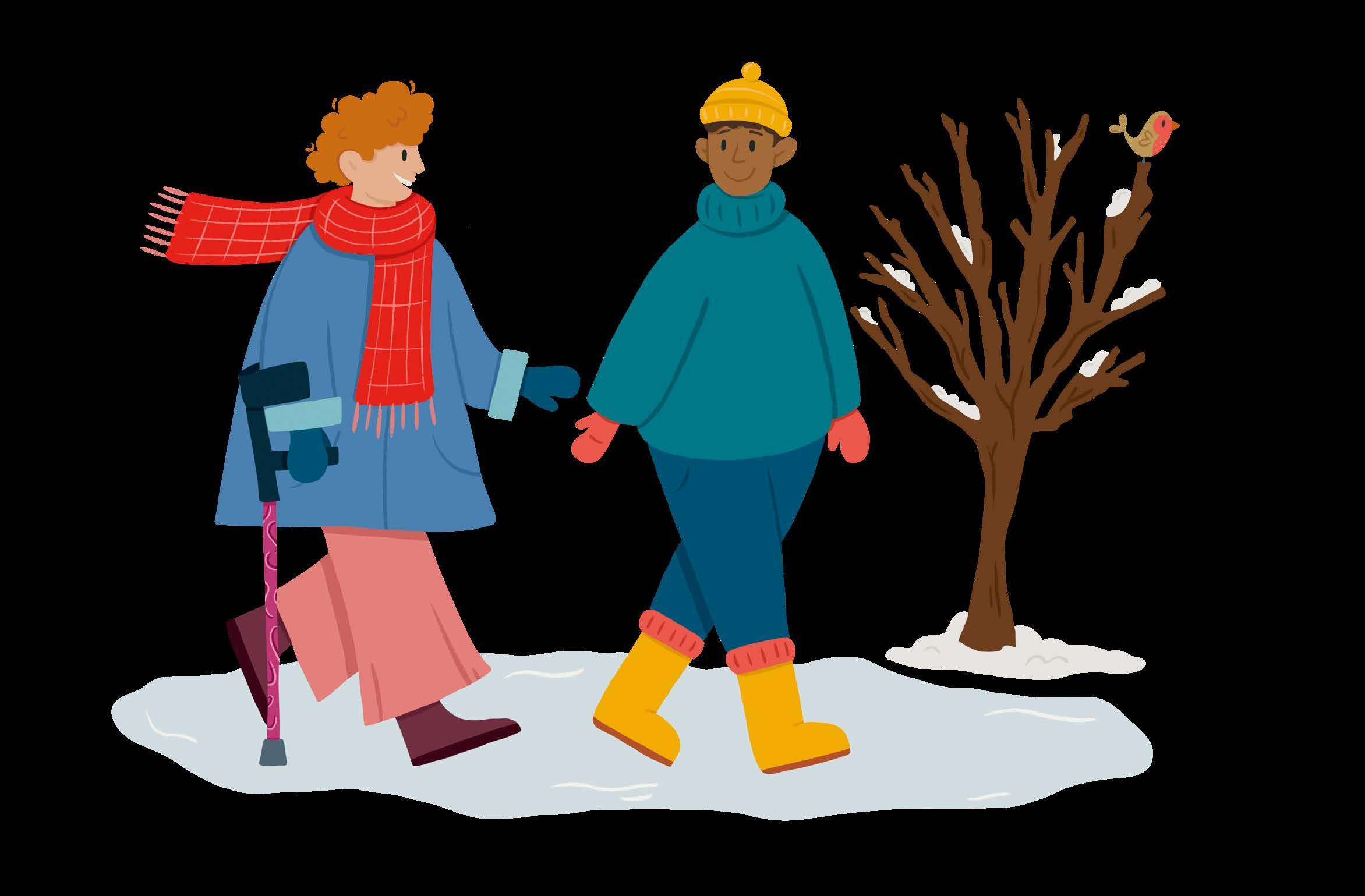
As the nights draw in and temperatures drop, it’s easy to want to stay home and hibernate. But keeping active during the winter months is vital to protect your mental and physical health
We all know the feeling – as soon as the leaves start to turn and the days get shorter, it’s bobble hats and sensible shoes dug out of the hallway cupboard. With the festive season fast approaching, a new exercise regime is the last thing on most people’s minds, but keeping moving and making healthy choices over the winter months is important to support your wellbeing.
Let’s start indoors, with seated exercises like chair yoga, resistance band workouts, or even seated Zumba, for a boost of music and fun to your fitness. These can be done in the comfort of home, with workouts available online – check out WheelPower and YouTube (our columnist Samantha Renke recommends @CarolineJordanFitness, @KymNonStop and @ZukFitness,), while Gympanzees offers a range of movement suggestions for disabled children.
There’s a whole world of accessible movement games online, including VR
games like Walkabout Mini-Golf, which provides seated options and lets you play with friends or other online players for a sense of community.
Contact your local leisure centre to see if they offer mobility classes like tai chi, qigong, yoga or Pilates. These can be adapted, and deliver added health benefits like mindful breathing and social connection. You don’t even need to attend a specialist class or watch a guided workout. Working movement into your everyday routine is a sustainable, simple way of keeping active – try squats or calf raises while brushing your teeth, or bicep curls using food cans while waiting for the washing machine cycle to end.
Spending time outdoors in winter can boost your mood by providing daylight and fresh air. As long as you’re dressed for the weather and are aware of your personal limits (is it too icy, will you get uncomfortable if you get rained on?), you can always find accessible outdoor activities. You’ll need suitable sturdy footwear, grippy mobility aids or even a
power pack on your wheelchair, along with appropriate clothing, heated blankets, and waterproof gloves. Be very careful of slippery leaf piles, black ice and snowy conditions – take a charged mobile phone with you, and go out with a companion if you can.
Why not head for a gentle walk or roll somewhere accessible, like a local park or National Trust property, or consider outdoor ball games with larger balls for easier handling? If you’re feeling active, you can look into Nordic walking with poles, adaptive cross country skiing and sledging, or inclusive walking groups. These are often run by local authorities, and provide accessible routes and social interaction.
Keeping moving and staying active over winter will improve your mood and overall health. Just go at your own pace, stay safe, and – above all – have some fun to brighten up those dark winter days.
FOR MORE INFORMATION Activity Alliance: activityalliance.org.uk Gympanzees: gympanzees.org WheelPower: wheelpower.org.uk




Feeling Grinchy about the Christmas season? Whether you’re neurodivergent and dreading the festive fuss, or you’re preparing yourself for another lonely silent night, Editor Melissa Holmes learns how you can make Christmas more manageable
From the moment the presents and decorations start appearing in shops, there’s that little festive tingle. Gifts to buy, dark nights and twinkling lights, family feasts… The countdown to Christmas is so exciting! But that’s not the case for everyone. Whether access is an issue due to your mobility, you know you’ll be spending the festive period alone, or bright lights, scratchy tinsel and festive playlists make you wish you could be somewhere else, it can be a tough time of year.
“Many neurodivergent children and young people struggle with the disruption to their regular routines that often comes with the festive season,”
explains Dr Freya Spicer-White, Chief Clinical Officer at Outcomes First Group. Different food choices, decorations and noises leading to sensory overload, and the pressure to engage socially can cause neurodivergent people to feel anxious, distressed, or have a meltdown. “Even well-intentioned traditions can feel overwhelming when they’re sudden, noisy, or unfamiliar,” says Dr Freya. Social occasions are a big part of Christmas – schedules get busy with office parties, nativity plays, church services and family get-togethers. But not everyone has a chock-full calendar packed with events. “Feeling lonely during the holiday season is a common experience for many of our Olden Goldies,” reveals Barbara Davey, who runs the Olden Goldies companionship

Dr Freya Spicer-White
Unwrapping presents can be an extreme source of stress for a neurodivergent child
service for older people in Paisley, Scotland. “It can make them feel more isolated – we all think about our lost loved ones at this time of year, and spending Christmas alone can amplify depression in older people.”
Then there’s the big day itself – opening gifts with the kids, sitting down for a festive feast with your extended family, or maybe facing the day solo with endless re-runs of Morecambe and Wise. For people who are neurodivergent, preparation is key. “The best support comes from reducing pressure and offering choice,” reveals Dr Freya. “Parents and relatives can help by preparing the child ahead of time. Some examples include using a visual schedule of what to expect when you’re going to a festive activity, like ice skating, or asking the relative you’ll be spending Christmas with to send photos of their house.”
Presents can be an extreme source of stress for a neurodivergent child – they don’t know what’s inside the wrapping and might worry about how to react to please the gift giver and the people around them. Dr Freya worked with a family who showed their daughter all her presents in the days leading up to Christmas, which were then wrapped and placed under the tree to be opened with family. “This might seem strange to some,” says the doctor, “but it was exactly what this neurodivergent young girl needed to enjoy her Christmas presents on her terms.”
For many neurodivergent people, rest is vital in helping regulate and manage the pressures of the season. Dr Freya suggests setting up a quiet retreat space as a place to escape when things get overwhelming. “You might think about giving your child a timeout card,” she advises. “They can hand this to you when they need a break, so they have some control over how and when they engage.” Fidget toys, noise-cancelling headphones and weighted clothing or blankets can also aid with sensory regulation. And, where possible, stick to the same mealtimes, sleep schedules, and calming activities to maintain the child or young person’s routine.
If you’re spending Christmas on

your own, enjoying the spirit of the season can seem challenging. But simple mindset shifts can help you get that festive feeling. Barbara says acknowledging your emotions and prioritising self-care are helpful steps. She also suggests getting out in nature: “Visit a park or woodland and get some light exercise. This can help lift your mood, plus dog walkers always love to stop and chat.”
Taking a visit to your nearest town or city, or even wandering round your neighbourhood at dusk is a lovely way to enjoy light displays, and coming home to a pot of homemade soup and your favourite hobbies – like a good jigsaw, brilliant book, or festive film – can really lift your spirits. If you do have family or friends, you can stay in touch through technology, like phone or video calls, or even share photos through a tablet or smart device. And if your low mood is getting you down, you’ll always find a caring listener via the help and advice
lines run by charities including Age UK, Samaritans and Contact.
Nothing beats in-person company, so why not check local community or church noticeboards, or online groups to find out about activities taking place in your area? As part of Olden Goldies, Barbara runs a warm and welcoming community hub offering a coffee shop plus activities like crafts, board games, and musical workshops. There are places like this across the UK, with seasonal food and drinks to help brighten up Christmas.
However you feel about this time of year, remember it’s temporary – once the decorations come down and the new year begins, it often feels as though the flurry of festivities never happened. There is support and help available if you need it, and bear in mind it’s ok to mark the season any way you choose. From all of us at Enable, happy Christmas – however the celebrations look for you.

























Discover the Magic 14 November - 01 January
Windsor, Berkshire
Children from £11, adults from £18
This illuminating, dog-friendly light trail brings seasonal sparkle to Windsor’s famed park. Spectacular installations, lasers and a field of light are the main attractions, while brand new Sensory Sessions on 25 November invite visitors to enjoy a more comfortable and inclusive environment. Delight in dazzling lights and floodlit fountains in the enchanting woodland wonderland. windsorilluminated.com

Exhibition Centre Liverpool / Free entry, register in advance
This fun-filled day out is packed with features and special guests, helping parents and carers of disabled children, along with the professionals who work with them, to explore innovative assistive technology. Visit the event for the most up-to-date information on solutions that help change young lives and enable everyone to reach their potential. This year’s North event takes place in Liverpool, and will include a Santa’s grotto, Kidz fun zone and accessible soft play. kidzexhibitions.co.uk/kidz-north

Have a jolly Christmas with our pick of accessible festive events across the UK

Unicorn Theatre, London / Tickets from £12.50
Ever wondered how Santa goes down the chimney? Feet first? Head first? On a zip wire? Can he post himself in a parcel? Head to Unicorn Theatre for this thrilling fusion of physical comedy, live music and anarchic fun to find out. With captioned, sensory adapted, BSL and audio described performances at this accessible, inclusive venue, this show offers something for everyone. unicorntheatre.com
Leeds, West Yorkshire / Market entry free, ice skating price TBC
Leeds hosts one of the UK’s favourite Christmas Markets, and this year is no exception. Visit Bavarianinspired market stalls, enjoy a Yorkshire pudding wrap under covered seating areas, or head to Millennium Square’s Ice Cube for ice skating: there’s a dedicated accessible skating session for wheelchair users and people with additional needs; all in addition to the general public skates that take place each day. visitleeds.co.uk
King’s Theatre, Glasgow
Various prices
Join Glasgow pantomime legend Elaine C Smith and funnyman Johnny Mac as they dive to the depths of the ocean in an exhilarating and enchanting theatrical extravaganza for this year’s pantomime at the historic King’s Theatre. With wheelchair accessible spaces in the stalls, accessible toilets, plus captioned, audio described and signed performances available throughout December, it’s guaranteed to be another box office smash! atgtickets.com


Bold, brave and brilliant, the jewellery and accessories designed by CapriceKwai certainly make a statement. Having modelled in London Fashion Week and worked with brands like Kurt Geiger, Dr Martens and ASOS, Caprice-Kwai – who uses mobility aids – knows all about unique style and self-expression. Her colourful clutch bags and eye-catching earrings are a must-have for anyone wanting to feel empowered and confident.
Prices start from £7 / capricekwai.com

Mesha Moinirad, better known to fans as Mr Colitis Crohns, has developed a support belt for people living with a stoma, abdominal scarring or hernia. Designed to provide support, enhance comfort and increase confidence, the belt is versatile enough for activities from swimming to climbing mountains, and provides great protection when faced with a leak. Available in three sizes, the support belt is moisturewicking and fast drying.
£85 / mrcolitiscrohns.com

From magical musicals to classic dramas and thought-provoking productions, a trip to the theatre is an enjoyable – and often accessible –experience. If you have a theatre lover in your life, Theatre Tokens make a great gift. They can be used at locations across the UK, and have no expiry date. With audio description, captioning, sign language interpretation and touch tours becoming part of many shows, there’s never been a better time to enjoy a night at the theatre.
From £25 / theatretokens.com
Our picks for the festive season, with many items from disabled-led businesses



Got a foodie friend with a sweet tooth? How about a festive gift box packed with brownies or delicious traybake treats from Mimi’s Bakehouse? Family-run Edinburgh bakery Mimi’s – founded by Michelle Phillips, who has multiple sclerosis – ships UK-wide, for those looking for serious Christmas indulgence. Options include biscoff mince pies and a red velvet Santa cake (pictured). Prices from £10 / mimisbakehouse.com

Representation is key in helping boost self-esteem, and the 3D-printed hearing aids, cochlear implants and BAHAs made by ToyLikeMe are the perfect inclusive accessory for any child’s favourite toy, helping children see themselves reflected in their play. Durable and child safety certified, they’ve been designed by Rebecca Atkinson, who grew up wearing hearing aids. From £13.99 / toylikeme.org

What better Christmas stocking gift than a pair of Christmas socks? This funky festive pair, from Stand Out Socks, helps support children with additional needs, as £1 from every purchase is donated to Cash For Kids. Stand Out Socks offers paid, meaningful employment to people with learning disabilities, so purchasing this stocking stuffer will have a real impact. £9.95 / standoutsocks.co.uk
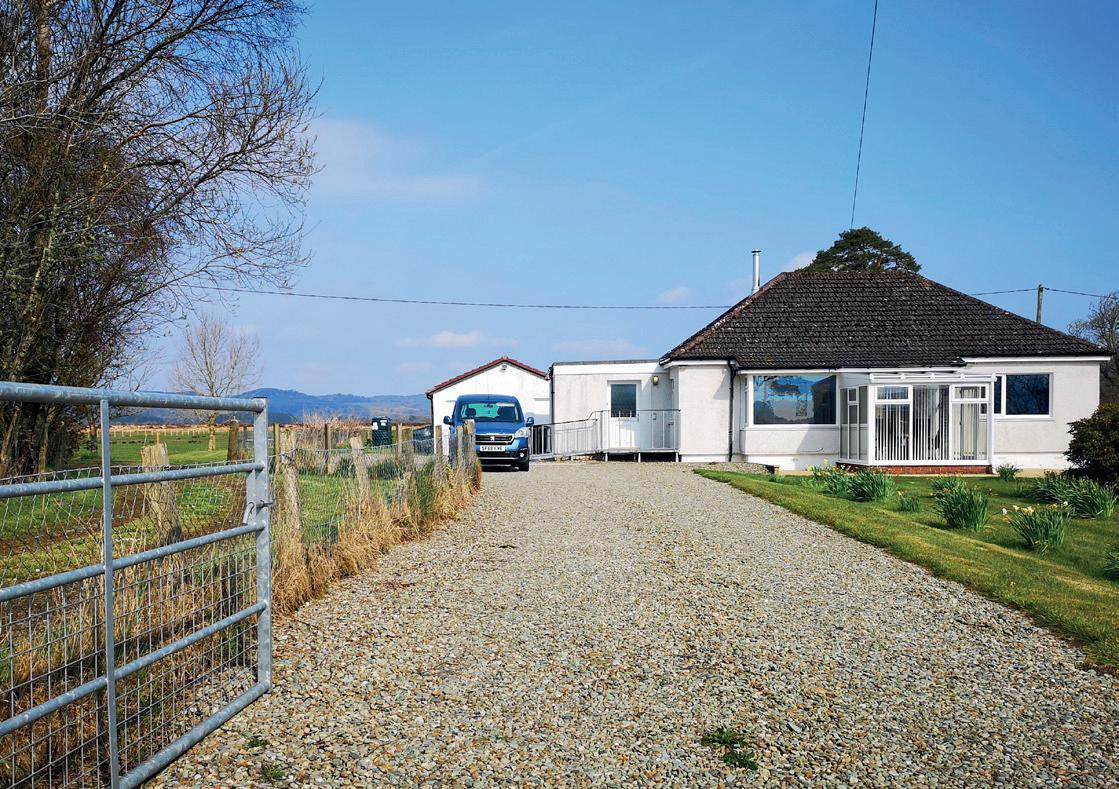
Beautifully presented modern self-catering bungalow in Scotland with spectacular views. Fully accessible for wheelchair users, with specialist equipment. Sleeps 5.
Meadowsweet is near Kilmartin Glen, in the Moine Mhor National Nature Reserve in Argyll. Heating and linen is provided. Fibre broadband, BT TV and WiFi.
•Level drive and ramp
• Alerta Low profiling bed
• Oxford Mini 140 hoist
• Freeway Tilting Shower Chair
• Fully adapted wet room
• Wide doors, spacious rooms
T: 07813 321731 Ruth Bebb ruthbebb@btinternet.com www.meadowsweetbungalow.co.uk
With audio described performances and touch tours available, there are more ways to experience the movement.







For ages 2+

Sensory Adapted Fri 5 Dec | 11am
Sensory Adapted Sat 6 Dec | 11am Captioned Sat 6 Dec | 2pm
Check out our Sensory Adapted, Captioned, BSL and Audio Described Performances here. Thu 4 Dec | 2pm
Sensory Adapted Sat 13 Dec | 2pm BSL Interpreted Sun 14 Dec | 11am
Audio Described Thu 18 Dec | 11am
Audio Described

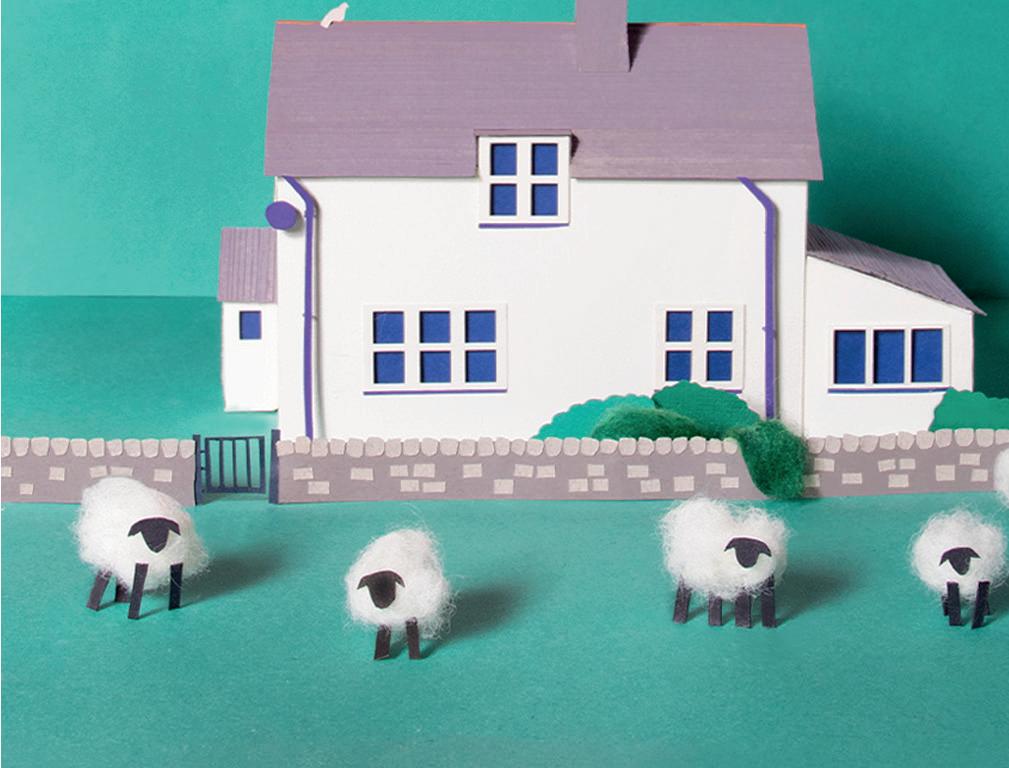















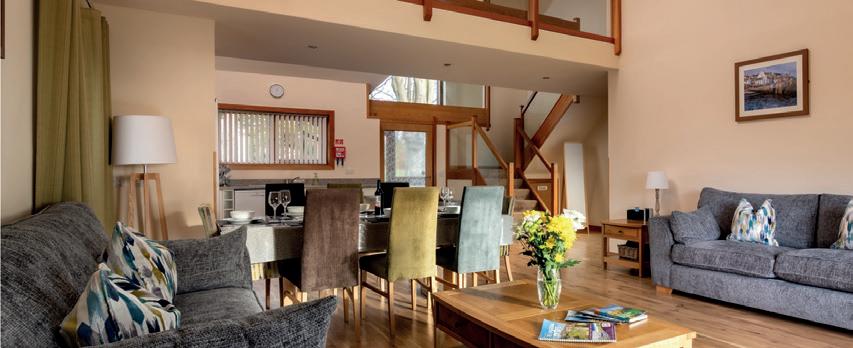

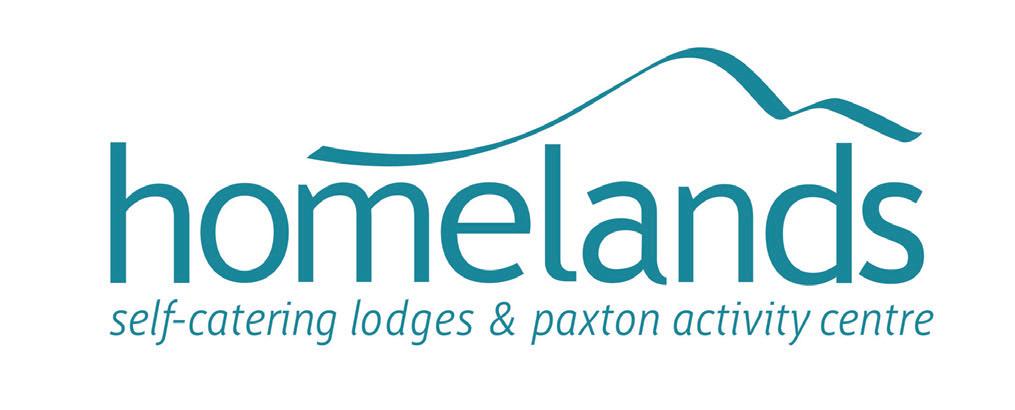

























































It’s that time of year when lots of us want to stay home and relax. But when you’re bored of watching TV and your to-be-read pile is dwindling fast, perhaps it’s time to think about getting a new hobby? Editor Melissa Holmes chats to gamers and a singer to discover more
Grey was playing video games as soon as they were old enough to hold a controller. Now 25, they’ve been a right arm amputee at the shoulder for 14 years. Grey says: “After I lost my arm, I found it almost impossible to play most games I’d enjoyed in the past, so I shifted to new ones. Once I became an adult, I started trying to figure out how to fully adapt and play the games I wanted to. From there, I started gaining online gaming
friends and joining the community fully.” Arman’s experience is similar, and he explains: “I’ve loved games since I was a kid, but it really turned into a passion during chemotherapy in my teens. Gaming was my way to escape that experience and stay positive.”
Both have discovered a real passion for gaming, along with making friends online and in real life. “During the

early pandemic, Animal Crossing New Horizons had just come out,” explains Arman. “It was like a portal into a new world. Friends and I would tour one another’s islands, and we’d hang out virtually when it wasn’t safe to hang out in real life. One of those friends, I’m delighted to say, is now my fiancée.”
Grey has had a great experience too, telling me: “I have so many friends I can hang with, even if they are states or countries away. It really helped rebuild my social life since I live so far away from most of my friends.”
If gaming isn’t for you and you’re not sure what hobby you might enjoy, think back to the pursuits you enjoyed when you were younger – perhaps board games, painting or baking – and also think about what you’d do now on your best day. You can also reflect on missed opportunities – perhaps you always wanted to be on stage or to work in nature: this might help you work out what hobbies you’d enjoy. Remember – whatever you try is meant to be fun; it shouldn’t be hard work and it doesn’t need to be expensive. Look locally for activities, ask online to see what others do, and enjoy trying out new hobbies until you find something that works for you.
Cassie joined Show Choir – a musical theatre community choir collective, with hundreds of members in groups across the UK – as a way of reconnecting with her love of performing. But it became much more than that. She describes it as a “gateway to a whole new life,” saying: “Through Show Choir, I met Chloë and her assistance dog, Ocho. That friendship was the turning point. With their encouragement, I was able to


accept my disability and start using a powerchair, which transformed both my independence and confidence.”
This accessible hobby has been life-changing in other ways – the confidence and headspace Cassie has enjoyed since starting at Show Choir has seen her launch her own business, Sandy Stones Travel, which specialises in accessible travel. She’s also worked with the Hidden Disabilities Sunflower organisation and joined initiatives like Purple Tuesday and Disability Rights UK. “These connections have led me to opportunities I never imagined, from performing at the Edinburgh Fringe and writing about accessibility, to being nominated for a West Country Woman of the Year award,” she says.
Arman’s hobby has led to much more too: he’s co-founded a platform called AbleToPlay. Working with world-leading non-profits like Safe In Our World, Neil Squire Society, Games for Change, and the World Institute on Disability, AbleToPlay matches gamers to games based on accessibility needs. “You make a private profile, add your preferences – perhaps you need subtitles and prefer adjustable control sensitivity – and you’re instantly matched with games based on how well they satisfy your needs,” says Arman. The free-touse platform is GDPR compliant and fully accessible for people using screen readers too.
Grey has found that being part of the gaming community has improved their life too: “Being able to play games with friends or even just relax has been good for my emotional wellbeing,” they reveal. “It’s a nice escape, and with

many games turning to free-to-play models, is even more accessible.” Arman has noticed positive improvements as well, telling me: “Just knowing there’s a community of gamers with diverse needs has been amazing.”
Grey says the gaming community is really helpful: “Even people with no disabilities are using what they have to try and develop controllers and gadgets to help make gaming more accessible. Video game companies are also starting to improve accessibility in games as well as the console makers themselves. The community is in a great space.”
Your hobbies might even provide scope to add new skills to your CV too – Cassie is now a Social Secretary for Show Choir, explaining: “I get to give back to the group that unknowingly set everything in motion.”
As these people’s experiences show, from friendships to a social life to the courage to embrace who you are, you have nothing to lose by trying out a new hobby, and everything to gain.



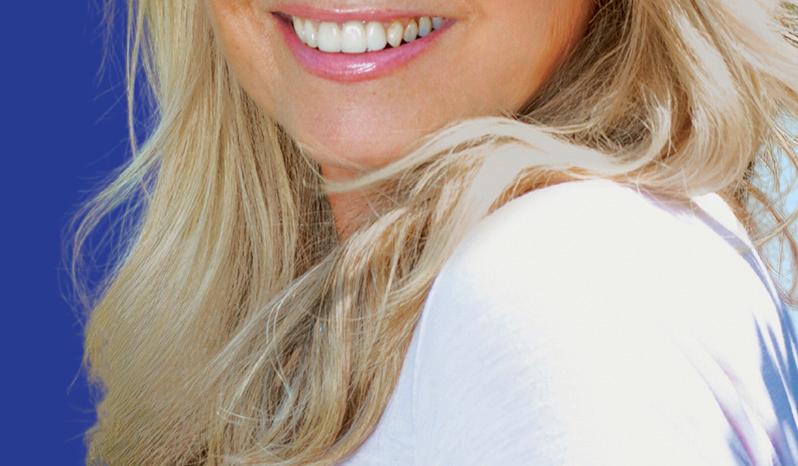


















Samantha is a broadcaster, actress, disability activist and the author of You Are the Best Thing Since Sliced Bread Follow Samantha on Instagram @samantharenke
Samantha Renke on the realisation of who she can really trust when it comes to supporting her access needs, especially during the busy holiday season
For some, this is the most magical time of year. Whether you celebrate Christmas or not, the winter months sparkle with festivities: school nativities, winter wonderlands, office parties, pantomimes. But if, like me, getting out and about – especially on dark, cold nights – is a challenge because of disability, the season can also feel incredibly isolating.
For years I found myself stuck in a loop: wanting to be the life and soul of the party, not wanting to disappoint anyone, even if it meant sacrificing my own access needs and boundaries. As I’ve grown older, I’ve learned to advocate for myself and turn down invitations when people or venues simply haven’t stepped up.
Of course, I’ll always call out disablism and ableism when I see it. But I’ve also noticed something else: there are only a handful of people in my life I truly trust with my access needs. That trust has a name. It’s called access intimacy.
Disability justice activist Mia Mingus coined the term. Access intimacy describes the deeply personal, often unspoken bond that forms when someone instinctively understands

and meets your access needs, not because they have to, but because they genuinely want you to feel safe, comfortable, and included. It’s more than physical access; it’s relational and emotional, rooted in care and trust.
For me, the person I trust implicitly is my mum. Of course, we share a mother-daughter bond, but it goes deeper. She knows me inside out. With her, my access and medical needs are never a burden. I feel completely safe.
For many Disabled people, access is usually transactional: a fight for ramps, interpreters, or basic accommodations, often met with resistance or dismissive excuses. “Sorry, we’re not accessible.” Or the classic: “Yes, we’re fully wheelchair accessible –there’s just one step at the main entrance.”
Access intimacy, though, is something else entirely. It’s when someone supports you not out of pity or obligation, but because your presence matters to them. It can be a friend who
carries your meds without needing a reminder, or a colleague who makes sure meetings are accessible before you even ask.
I’m approaching my 40th birthday, and I’m heading to Mexico with two of my closest friends. Straight away, I fell into internalised ableism. I said I understood it would be difficult if they had to carry me at times due to inaccessibility. They immediately shut me down – not with annoyance, but with love: “It’s never an issue for us.” That, right there, is access intimacy.
In a world where access is so often an afterthought, access intimacy is a quiet act of resistance. It reminds us that accessibility isn’t just about compliance but connection.
Letting go of the fear of being a burden isn’t easy. But those who love you want you in their world. They want to spend time with you, exactly as you are.
This festive season, I hope you find and cherish that intimacy too.
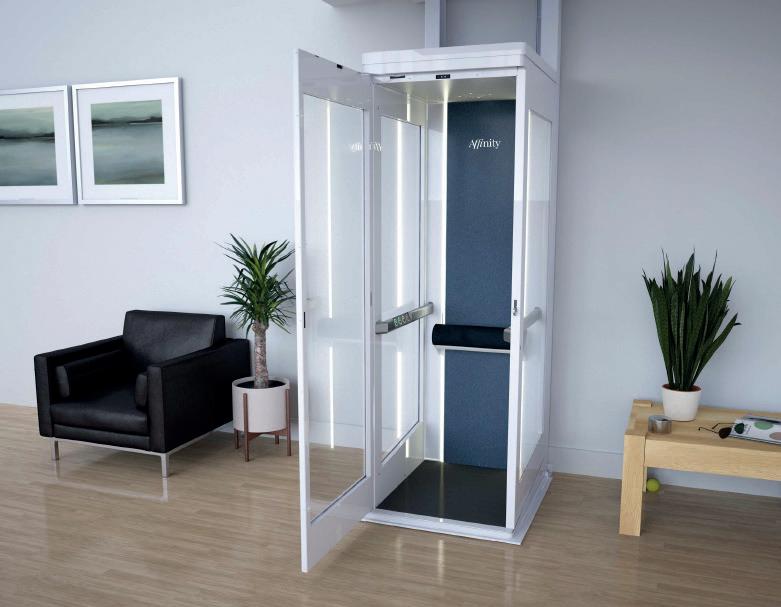

Renowned
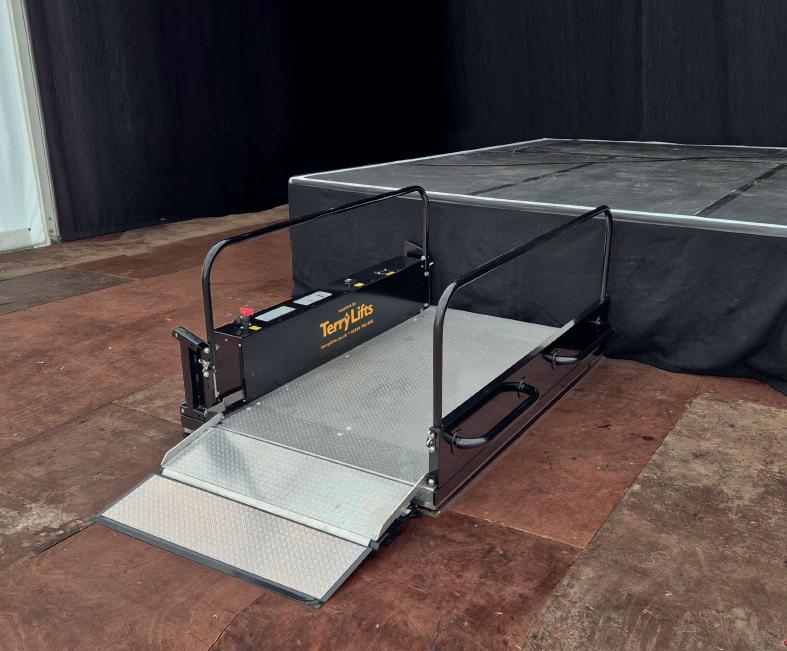





When adventurers Ed Jackson and Luke Tarrant set out for the remote peaks of Kyrgyzstan, they weren’t chasing records or glory. They were chasing something bigger: a chance to rewrite what it means to explore. Neither of them could have predicted what would happen next. They speak exclusively to Kate Stevenson
The idea had been brewing for years. Ed, a former rugby player who rebuilt his life after a spinal cord injury, had heard about untouched mountain ranges in Kyrgyzstan. These landscapes were supposedly so remote that no one had ever stood on some of their peaks.
“It wasn’t about ticking a box or going up high,” recalls Ed. “It was about going somewhere no human had ever been before, and putting a flag in the ground for adaptive adventure.”
When he met Luke, the plan began to take shape. Luke was adjusting to life as an amputee after losing his leg in a motorbike accident while travelling in South America. At the time, he was still physically recovering, emotionally processing, and trying to make sense of a life that had changed overnight. “I asked him to come out to Kyrgyzstan with me,” remembers Ed. “I could see
he needed to clear his head, escape from the noise, and think about what was next.” The pair also decided to use the First Ascent challenge to raise funds for Ed’s mental health charity, Millimetres to Mountains, and CDI’s Children at Risk programme for disabled kids in Kyrgyzstan.
Over the next few months, Luke threw himself into the challenge and the training. “I’ve always been an advocate for getting out there and living your life to the fullest,” he explains. “Now that I’m disabled, it hasn’t changed. It’s still my mantra. There are just extra considerations now.”
When the team reached Kyrgyzstan in late summer to start their ascent, anticipation was high, and their spirits were light. “We were laughing and joking, looking forward to the climb,” remembers Luke. “Then, within
minutes, the whole thing was off.”
A painful swelling had appeared on Luke’s stump. On advice from his rehabilitation team back home, he visited a local clinic to have a small amount of fluid drained in what should’ve been a simple, routine procedure. Shockingly, what followed was anything but routine.
“They assured me they understood and could carry out the procedure,” says Luke quietly. “In reality, this probably wasn’t true.”
“Things took a turn for the worse, and I ended up with a much bigger wound on my leg than I was expecting. It cancelled the climb for me completely.” Within hours, his condition deteriorated: Luke now needed emergency surgery. What was meant to be a minor treatment had spiralled into something very traumatic for him. So much so, that Luke has since spoken out on social media about the medical
malpractice which took place, and his vulnerability in a foreign hospital.
“The hardest part was that I wasn’t expecting it,” he sighs. “When I was in Colombia years ago recovering, every day was a grind, and I knew it would be hard. But in Kyrgyzstan, everything was fine, and then it wasn’t. It took me completely by surprise.”
Back at base camp, Ed was nervously waiting for updates on Luke’s condition. Eventually he was told Luke was being flown home. “I was shocked. Gutted for him, and gutted for myself,” he admits. “My first concern was his health. The mountains weren’t going anywhere after all.” But suddenly the climb now hung in the balance: should Ed continue alone, or return with Luke once he’d recovered?
After speaking with Luke, Ed decided to continue and finish the ascent – not just for himself, but for his friend, the charities, and for everyone whose mission it represented.
“I felt like I was carrying the torch for both of us,” he remembers. “Adventure is all about showing up and adapting when the plan falls apart, whether that’s on the side of a mountain or in life.”
The climb that followed tested every ounce of Ed’s resilience. On steep ice, his adaptive technique – dragging one leg and balancing with modified crampons – was pushed to the limit.
“There was one point where my calves were screaming, and I thought, one mistake and that’s it,” recalls Ed.


“Except I realised I didn’t need super strength, I just had to break the climb down into small steps. That’s how I learned to walk again, and that’s how we got to the summit.”
When Ed finally stood atop the unnamed 5000 metre peak, he fulfilled a promise to the local children from a Kyrgyz orphanage and named it in their honour. They chose Hope Peak, which – all things considered – was very fitting.
Now home, Luke is continuing to heal, both physically and emotionally. “I’m still heartbroken I couldn’t complete the challenge,” he admits. “But I’m happy Ed managed to, and that it’s been done for a great cause.”
“I’ve got unfinished business with mountains now though!” adds Luke. Despite everything, his spirit for adventure remains undimmed. “This hasn’t changed my mindset at all,” he says. “Being disabled just means doing things differently. My leg isn’t going to grow back. This is my life now, and I’ve made peace with that. Because, when I put my mind to something, there’s no stopping me.”
Both men are also already talking about what they should do together next. “Setbacks don’t mean it’s over,” Ed reminds me. “They just mean the story’s taking a different turn.”
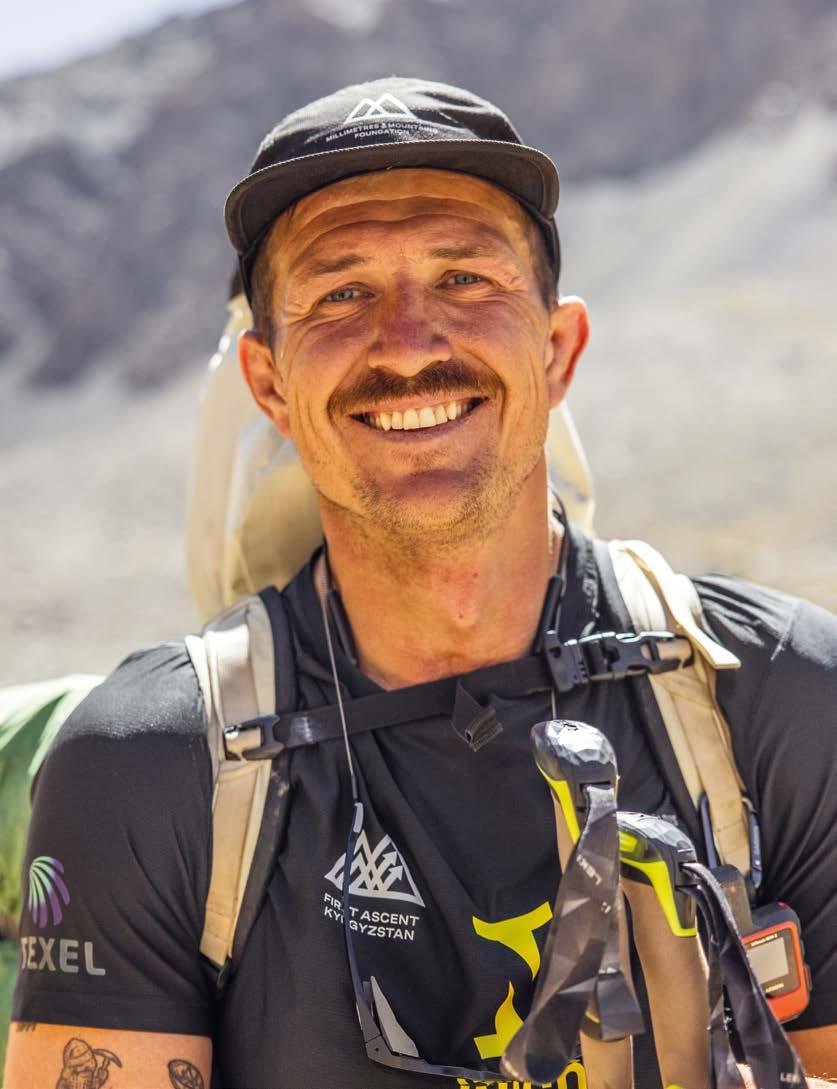
Setbacks don’t mean it’s over. They just mean the story’s taking a different turn
Ed Jackson
This issue, one lucky Enable reader will win an Echo Show 8 worth £149, which has a smart touchscreen with spatial audio, smart home hub and Alexa
The Echo Show 8 is perfect for staying in touch with friends and family over the Christmas period and beyond, thanks to hands-free video calling, a centred, auto-framing 13MP camera, and noise-reduction technology. With this issue’s reader prize from Enable magazine, you can also control your smart home devices like lights, thermostats and locks, as well as stream rich-sounding music, shows and HD video.
The Amazon Echo Show 8 offers the latest in smart home technology. The vibrant 8” touchscreen lets you display your favourite photos and memories, while adaptive colour makes the screen look great in any light. You can use your voice to set timers and update lists which link through to your phone via the Alexa app – perfect for staying on top of your shopping list. The Echo can also provide a glance at your calendars, and reminders to help you stay on top of appointments and events.

It even has smart accessibility features, like adaptive listening (where Alexa gives you time to finish speaking), text captioning features, Show and Tell for visually impaired users, and a screen magnifier function. So what are you waiting for? Enter today for your chance to win!

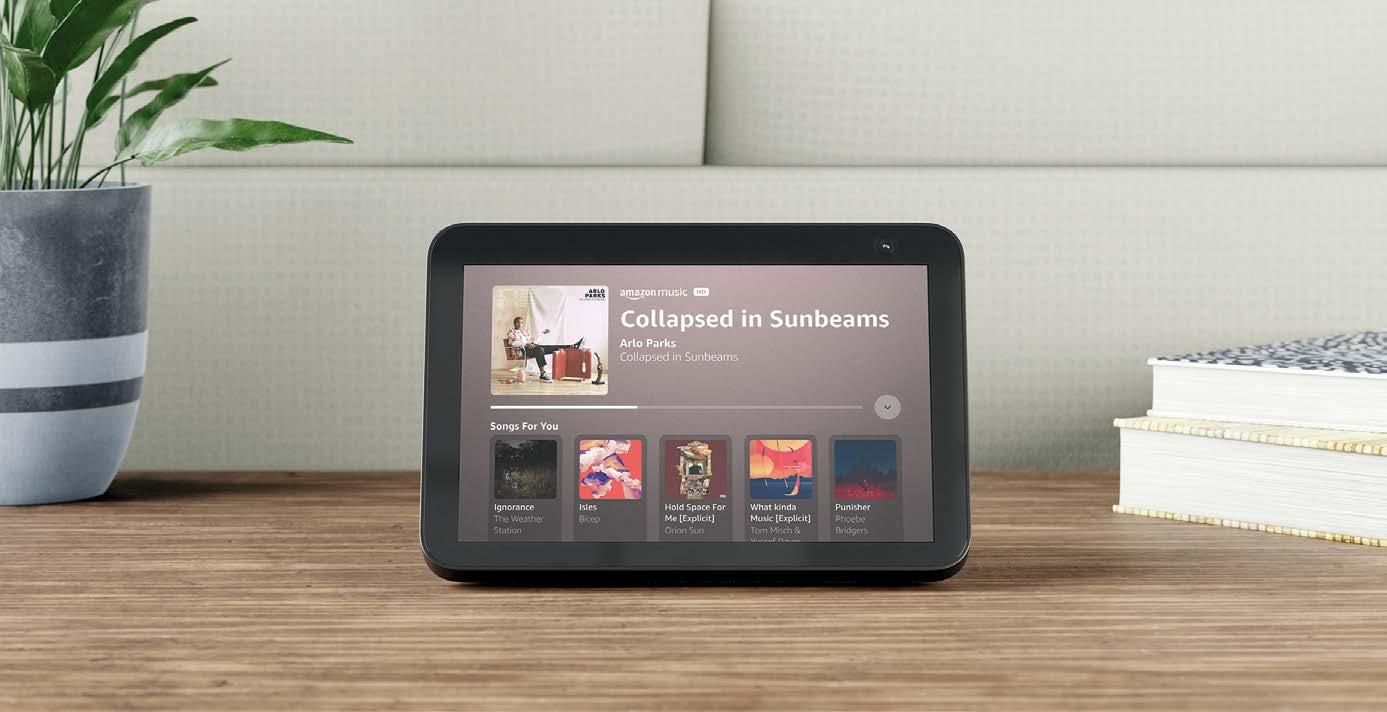
Simply send us your name, contact details and where you picked up your copy of Enable magazine. All entries must be received by Monday 15 December 2025. Good luck!
TERMS AND CONDITIONS: All entries must be received by Monday 15 December 2025. The prize is an Echo Show 8, which will be sent to the winner. The prize is nontransferable, non-refundable, there is no cash alternative, and it cannot be sold to another party. The prize may require additional subscriptions to streaming services. The contents of the prize may differ from the images and descriptions included here. One entry per household. This competition is not associated with Amazon. The publisher’s decision is final. If you do not wish to receive further communications from Enable magazine, include ‘opt-out’ in your entry.


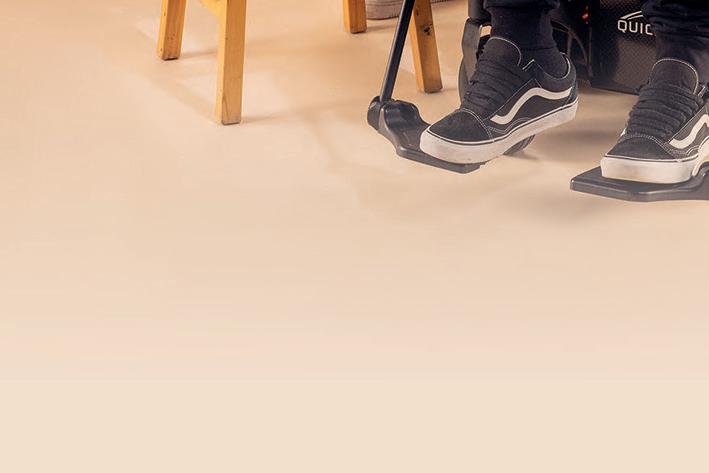

B.adaptive joggers and shorts are designed especially for wheelchair users or those needing extra help. These unique jogging pants ensure full coverage while sitting – so you don’t have to worry about flashing!

The functional front-opening zip enables easy and clean self-catheterising, whilst the high-rise back ensures complete comfort. Made from a sustainable, comfortable jersey fabric and available in four stylish colours.

For two decades, broadcaster and disability advocate Sophie Morgan dreamed of seeing a mannequin that looked more like her. Now, in collaboration with Primark, her vision has rolled onto the high street. She tells Kate Stevenson about the project that’s been 20 years in the making
In the heart of Oxford Street, the mannequins in Primark’s window look back at me. They stand tall, frozen in place. Plastic reminders of fashion’s obsession with perfection.
Except today, one figure breaks the mould. She isn’t standing. She’s seated, poised in a sleek wheelchair, wearing a denim jacket and an easy smile. Her name is Sophie, and her presence marks a quiet revolution on the high street.
For years, television presenter and disability advocate Sophie Morgan was told there wasn’t room for a seated mannequin in shop window displays, or that the industry wasn’t ready.
“I’ve been waiting for nearly two decades,” reveals Sophie. “To finally see a seated mannequin in a shop window feels surreal. It’s a full-circle moment.”
Created with Primark’s visual
merchandising team, the mannequin has been designed to represent wheelchair users – and to reflect millions of disabled shoppers. Although it may look like a small addition to an in-store display, in truth, it’s a big step for representation.
In fact, Sophie first started asking about the possibility of creating a seated mannequin when she was an art student, not long after the car crash in which she became paralysed at 18.
The question she wanted to address was simple: if mannequins influence how we see beauty, style and normality, what message does it send when none of them sit? “I remember going shopping and never seeing myself reflected. I wanted to change that,” says Sophie. “It wasn’t just about clothes: it was about belonging.”
So, in 2009, she created the

Mannequal™, a prototype of a wheelchair for mannequins. It attracted a lot of attention – but no action. “That hurt,” admits Sophie. “I was young and idealistic so, when brands said no, I took it personally. Eventually I stopped trying. It was too painful to continue.”
Still, Sophie never forgot about the Mannequal. While she was building a successful career as a broadcaster and campaigner, the prototype lingered in the back of her mind as she waited for the world to catch up.
It took nearly 20 years for that day to come. Primark, who had already developed an adaptive clothing range for disabled people, approached Sophie to see if she could help them design a prototype.
Over 12 months, Sophie worked closely with them to refine every detail: the height of the backrest, the curve of the spine, the angle of the wheels, and so on. “Her legs are slightly atrophied, her arms look strong, and her posture is gently curved,” explains Sophie. “Because, naturally, that’s what happens when you sit all day. The only way for the mannequin to look real is if her experience feels authentic too.”
The Sophie mannequin is appearing in Primark stores across the world, from shop windows in the UK, to Milan,
To finally see a seated mannequin in a shop window feels surreal Sophie
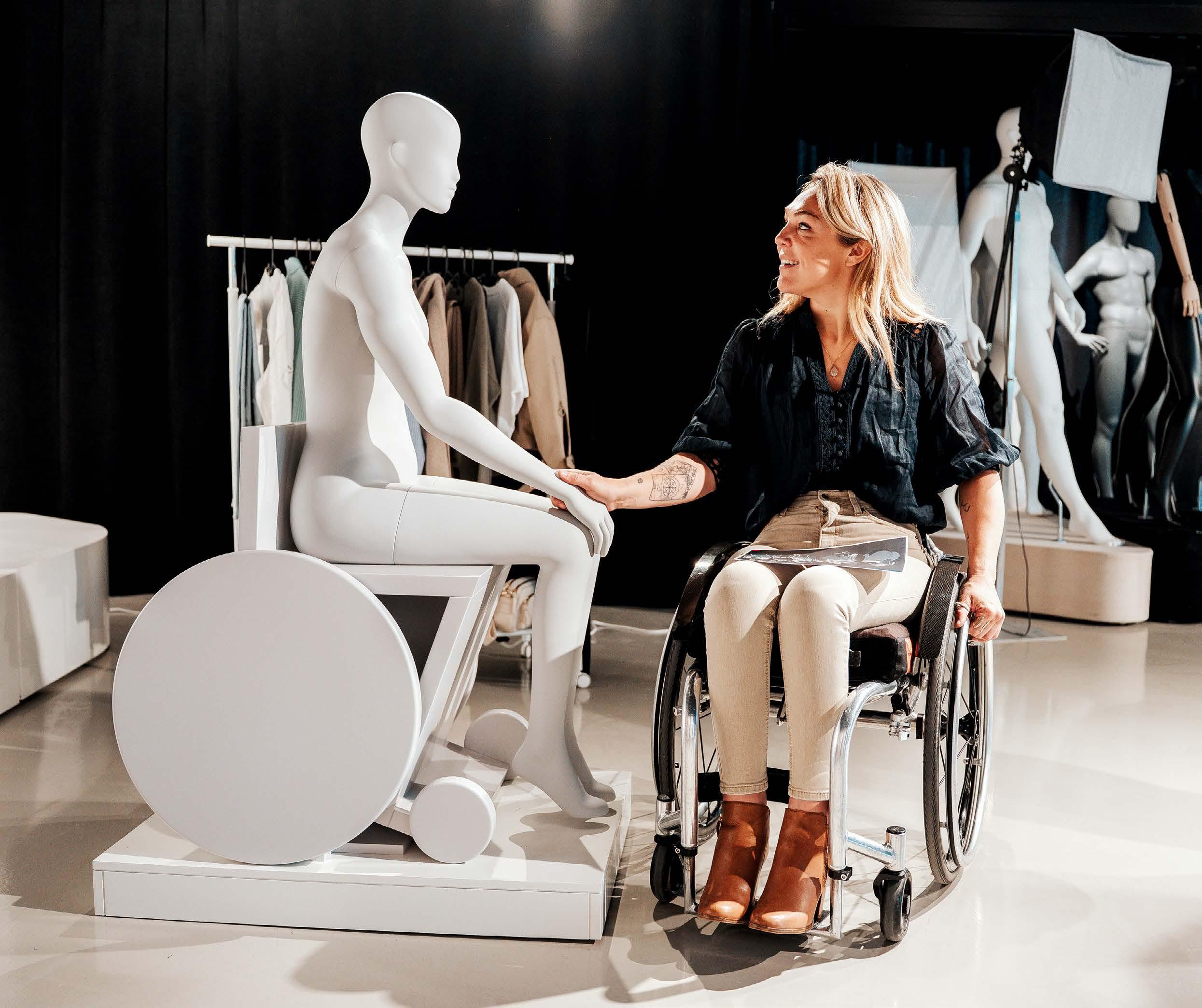
Prague, Barcelona and even the USA. Each one will come with a styling guide so store teams can select outfits that work for a seated figure.
Sophie believes this will ensure each look will be both stylish and functional: “I want people to look at her and think ‘That outfit would work for me’ – the same way anyone else would.”
Here’s the thing though. While it’s an important step for disabled shoppers, should it really have taken 20 years?
As Sophie says, fashion may pride itself on creativity but, when it comes to disability, it’s been slow to evolve. The adaptive clothing market was worth $15.8 billion in the US alone in 2024, and its value is predicted to double by 2031 – yet inclusive representation still lags behind.
Sophie doesn’t understand why brands don’t invest more in the purple
pound. At this point, being inclusive isn’t just the right thing to do, it’s simply good business strategy.
“The fashion industry is one of the most imaginative in the world, yet so limited in its thinking when it comes to body types and inclusion,” adds Sophie. “Designing for different bodies should be exciting, not a burden. Instead, the industry keeps creating for the same standardised shape.”
That said, a handful of companies have already started to change that narrative. Tommy Hilfiger, Nike and ASOS have all introduced accessible clothing lines in recent years, as well as experimenting with magnetic fastenings, sensory-friendly fabrics and adaptive fits.
But Primark’s seated mannequin takes inclusion to the next level, and the response has been overwhelming. “It’s been the most life-affirming, joyful, heartfelt thing. It’s magical,” Sophie
smiles. “People have told me they finally feel seen. That’s what this is about.”
In the end, the power of The Sophie lies in her quiet normalcy. She doesn’t shout, she doesn’t demand. She simply sits, stylish and still, in a space that for too long pretended she didn’t belong.
“Of course, this is a milestone, but it’s just the start,” affirms Sophie. “If other retailers are interested – get in touch.”
And, as shoppers pass the Oxford Street window, they may not realise the years it took to put The Sophie there. But, for those who do, she’s a hopeful reminder that visibility has the potential to change everything.

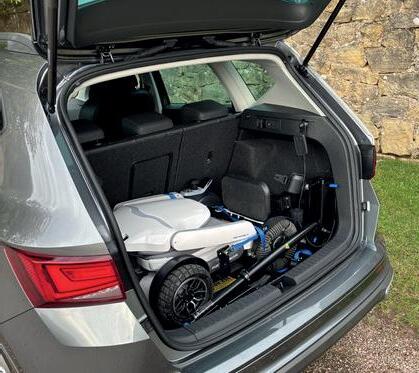







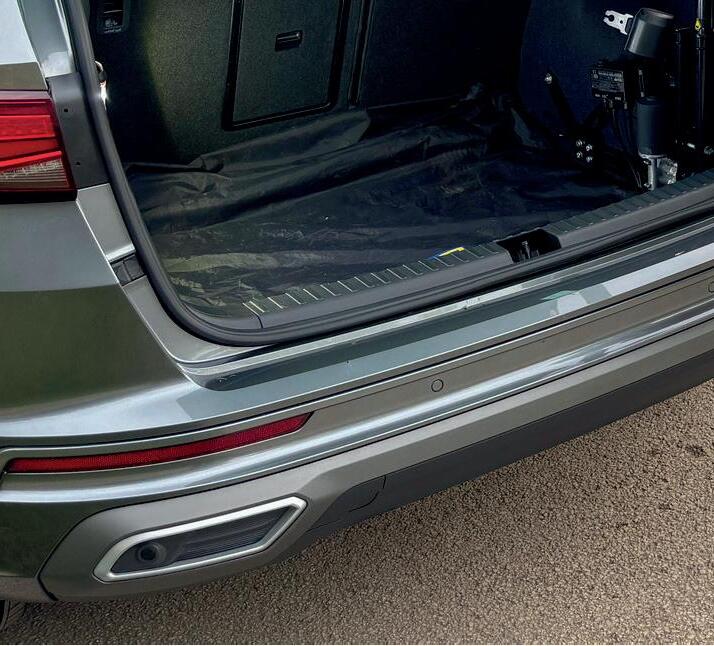
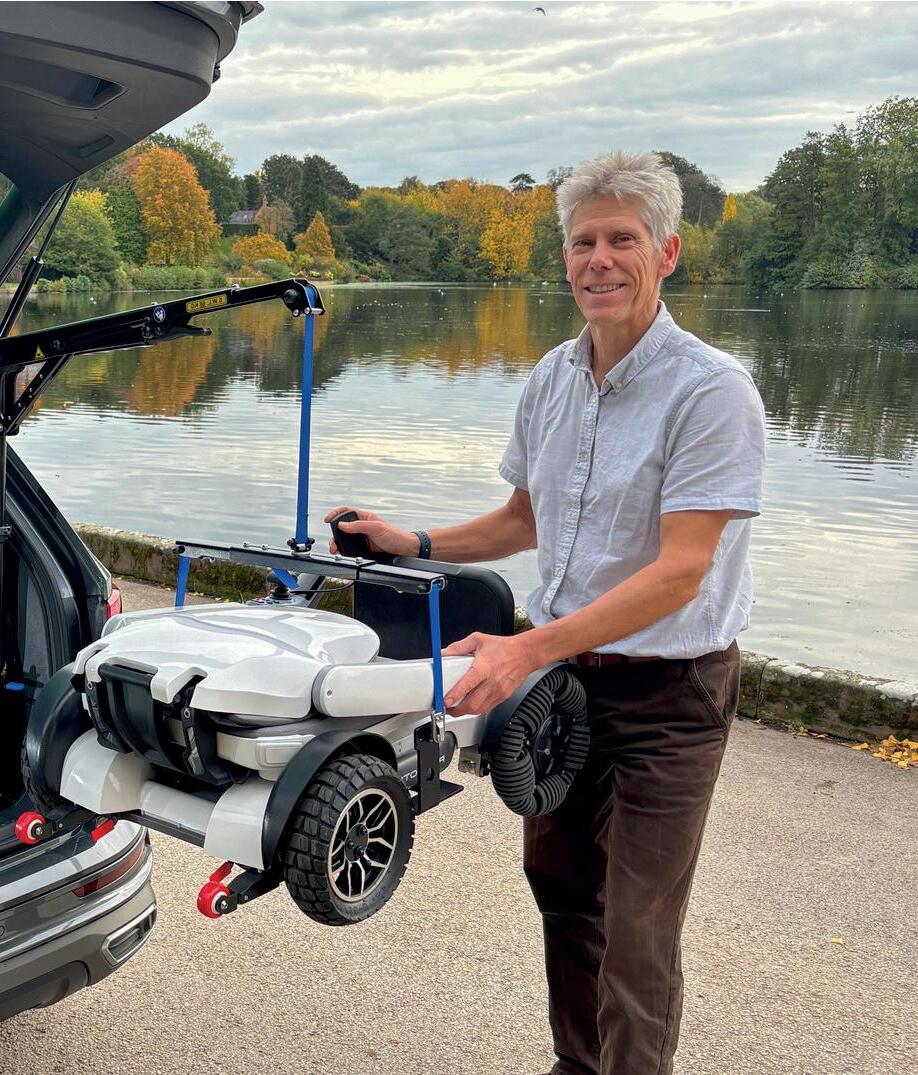





From long waiting times to inaccessible premises, dental student Molly Connelly reflects on how children with additional support needs can access quality dental care

For many people, a trip to the dentist can be daunting. Whether it’s the sound of a drill or worries regarding treatment needs, heading for a checkup can be challenging. For families of children with additional care and support needs, there are often extra hurdles to consider.
Great dental care starts at home, and prevention of dental decay is a vital part of overall health and wellbeing. In the UK, extraction of decayed teeth under general anaesthetic is the primary reason for which children are admitted to hospital. To avoid this, children should brush their teeth twice a day using the correct strength of fluoride toothpaste for at least two minutes each time, and brushing should be supervised or assisted, depending on the child’s age and ability. After brushing, it’s important to spit the toothpaste out, rather than rinsing with water. And at night, there should be ‘nothing after brushing’.
Toothbrushing can be more
challenging for children with additional needs. There are a variety of toothbrushes available that aim to make brushing easier. For example, adapted handles can be helpful for children with limited mobility and dexterity, while three-sided toothbrushes that clean all surfaces of the tooth at once can be helpful for children with sensory issues. For children with sensory sensitivities, the minty flavour of toothpaste can present a challenge, so look for flavourless and non-foaming toothpastes. In addition to good brushing habits, maintaining a healthy, low sugar diet is important – you can discuss with your dentist ways to reduce sugar intake and the possibility of sugar-free medicine options.
Regular check-ups at the dentist will complement a good toothbrushing routine at home, and visiting the dentist is vital to ensure good dental health for your child into the future. This is especially important when we consider some children with
additional needs may be less able to communicate pain and discomfort to their families and/or carers.
For families and carers of children with additional care and support needs, simply getting to the practice can be challenging if transport and/or suitable parking aren’t available, while a lack of assistive equipment in the practice is also a consideration.
What’s more, a trip to the dentist – with its sights, sounds and smells –can be overwhelming. It also means a break from a child’s familiar routine, which can add extra stress.
Prevention of dental decay is a vital part of overall health and wellbeing
1. Prevention is always better than cure. Prioritise your child’s oral hygiene at home and minimise dietary sugars to reduce the risk of dental decay.
2. Be regular: Early intervention is key to good dental health, so make routine dental appointments rather than waiting until a problem presents.
3. Timing: Try to book appointments for a time in the day when your child is most relaxed.
4. Acclimatisation: Ask the dentist to send a video of the practice and pictures of staff (these are often available on dental practice websites). Try to arrange an appointment to familiarise your child with the setting, without getting any treatment. You can even ask the dentist to provide you with a plastic mirror to practice looking in your child’s mouth at home.
5. Distraction: Headphones or ear defenders are great to reduce loud noises, and bringing a favourite toy or comfort item to the appointment can help keep your child calm.

Across the UK, NHS dental care for children is free. However, as with many areas of the NHS, specialist services are under increased pressure, and long waiting times can be a further barrier to accessing appropriate care.
In the UK, NHS dentists are required to treat patients with disabilities fairly and make reasonable adjustments where needed. If a general dentist feels that specialist care is required, they can refer the patient to a dental hospital or Community Dental Service who may provide more tailored care for patients, often with longer appointment times and, in some instances, with home or school visits available – perfect for children who struggle with being in unfamiliar environments.
Dentists working in these services have additional training to help manage challenges, such as in communication
techniques, and clinics are often equipped with specialist equipment like wheelchair recliners for those patients unable to transfer to a dental chair. They can also offer alternative treatment options when required; for example, sedation and general anaesthetic.
Dentistry is constantly evolving, with many new treatments becoming available. One minimally invasive treatment (no drill, no injection) that may be discussed with you is placement of a metal cap on a decayed baby molar by the ‘Hall Technique’.
A recent study in the British Dental Journal found this can be an effective alternative treatment option for children with learning disabilities which, in some cases, may avoid the need for a general anaesthetic and tooth extraction.
Parents and carers can also access
additional help through services such as Scotland’s national oral health programme (Childsmile, Open Wide, Caring for Smiles), and in England via the Starting Well initiative, which is part of SMILE4LIFE.
While there can be access barriers within dentistry, research is continuing to find new ways of improving treatment and support. Good dental care for children with additional needs depends on teamwork between families, dental professionals, and everyone involved in the child’s care, with the shared goal of putting the child’s best interests and needs first.
Childsmile: childsmile.nhs.scot
NHS advice: nhs.uk/live-well/healthy-teethand-gums


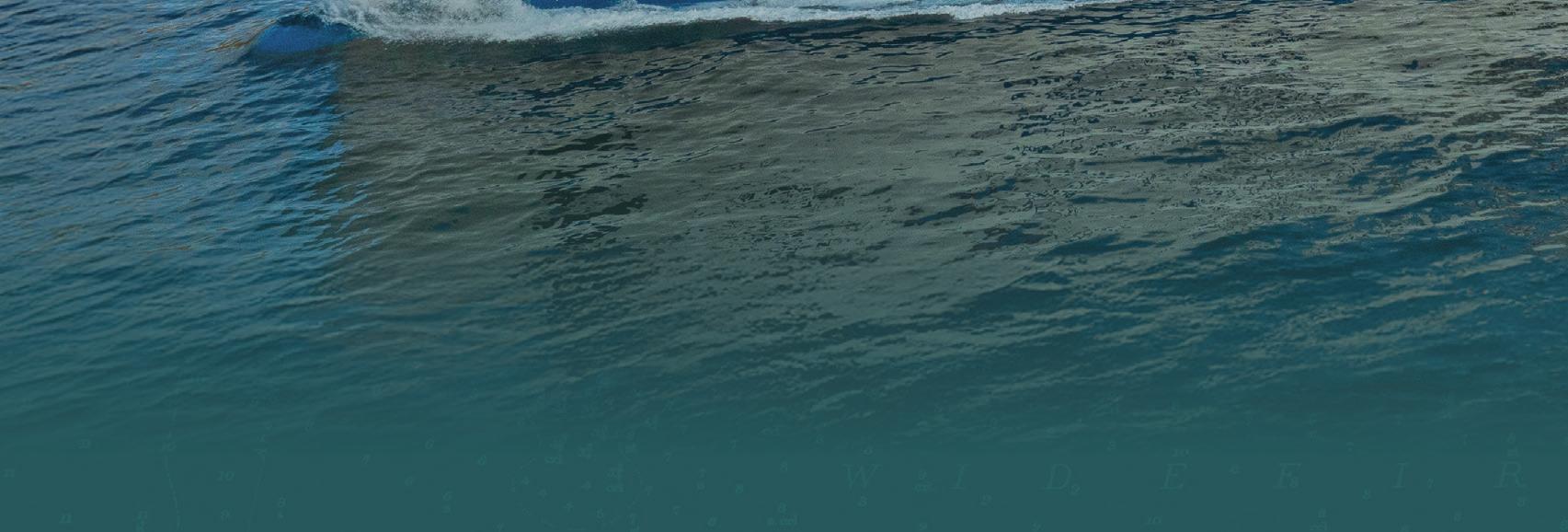



Your holiday in the beautiful Northern Isles begins as you set sail with NorthLink Ferries.
The comfortable and reliable service offers sailings from Aberdeen to Lerwick, Shetland, with regular calls into Orkney’s capital of Kirkwall.
Alternatively travel from Caithness to Orkney’s port of Stromness. This 90-minute journey passes the iconic sea stack, the Old Man of Hoy.
From booking, to boarding, then experiencing the journey onboard, we have a range of services and accessible facilities available that can be tailored to your needs.


























































































































Homelessness is on the rise amongst disabled people. We investigate the causes, and look at what support is available
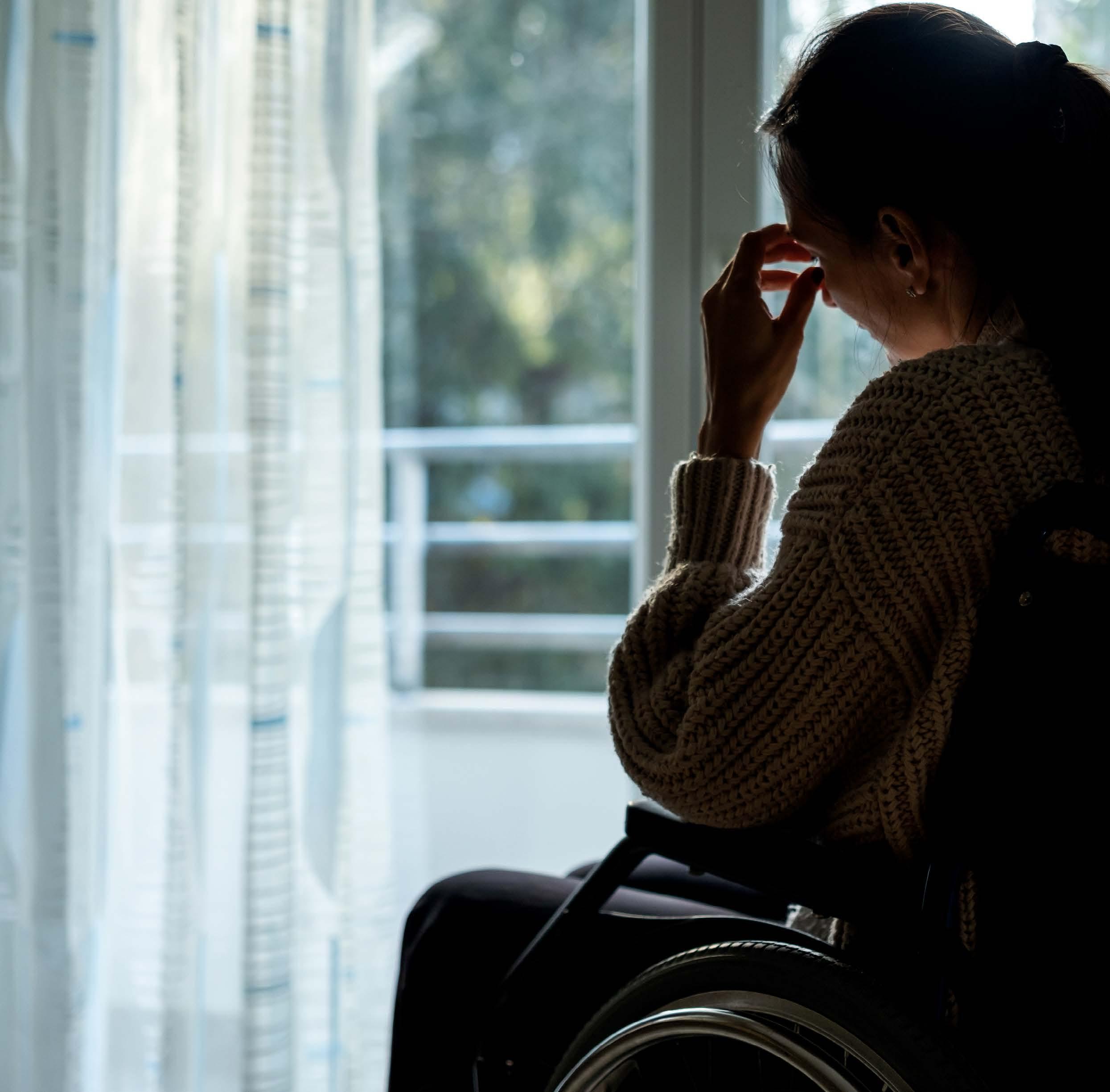
Think of homelessness, and most of us picture someone in a ragged sleeping bag, sitting on the street, holding a cardboard sign and begging for money. But the classic image of a rough sleeper is far from the reality of the one in every 200 households experiencing homelessness in the UK. In fact, the vast majority of homeless people don’t live like this. They might be based in insecure accommodation (like families in emergency and temporary accommodation), or classed as hidden homeless, meaning they’re
couch-surfing, staying with friends or family, or even living in their cars.
And a high proportion of homeless people are managing their challenging circumstances while living with disability, chronic illness, and mental health troubles. For disabled people, the risk of losing their home is greater due to unstable financial situations, like the extra costs that come with being disabled, increased reliance on benefits, difficulty in finding or keeping a job due to systemic discrimination and inaccessible roles, and the problems associated with securing accommodation that meets their
needs. What’s more, the path back to finding a roof over your head can be more difficult too.
There’s no single pathway to homelessness – it can be caused by a complex mix of factors. Personal circumstances, like loss of a tenancy or facing eviction because a landlord chooses to sell; economic reasons, like rising rents, cost of living pressures, and the gaping difference between housing benefit versus the cost of private rent; and social issues, such as the breakdown of a
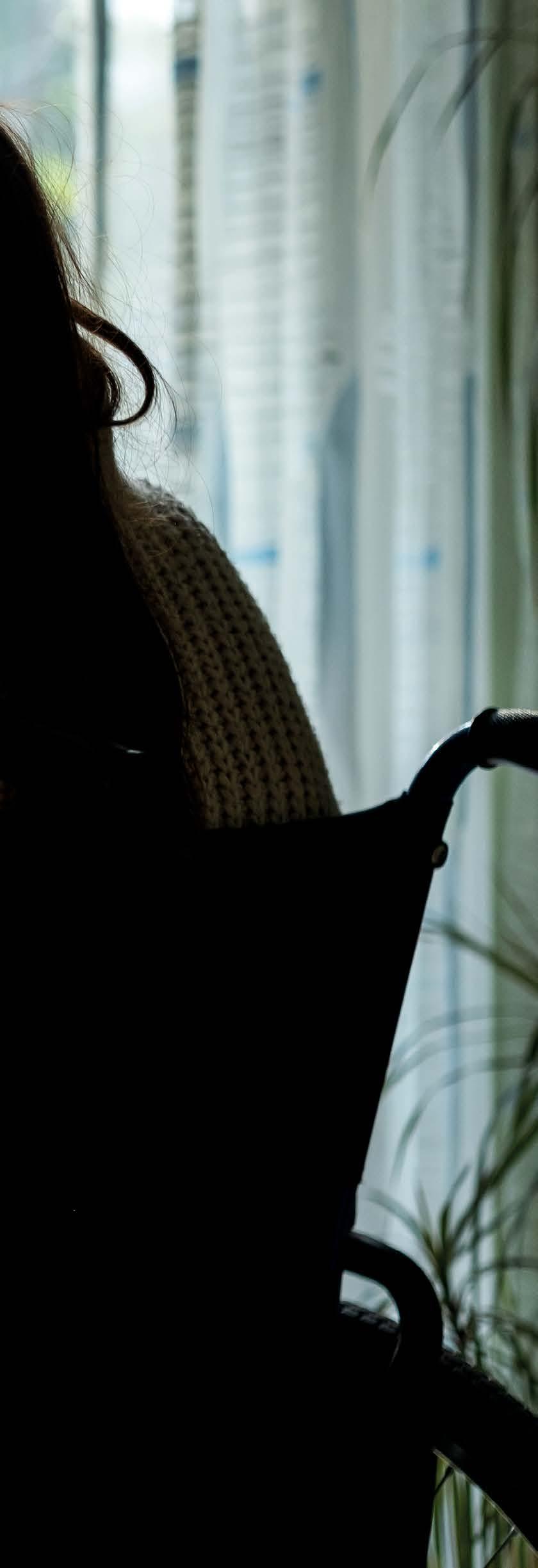
Matt Downie, Crisis
relationship, leaving the care system, being medically discharged from the military, or losing your job, can all coincide to create a tipping point that pushes someone into homelessness.
The reality of homelessness is stark. From being unable to prepare a hot meal, to being forced to rehome a pet because you can no longer keep it, the impact of losing your home can be lifechanging. Growing up in temporary accommodation with no space to do your homework or no room to bring your friends over to can leave a lasting impression on a child experiencing homelessness, while trying to survive winter living out of the back of a car – especially if you have health conditions – doesn’t bear thinking about. But it happens. According to Shelter, half of working renters in the UK are only one pay cheque away from losing their home.
And the scale of homelessness among disabled people makes for shocking reading. The Office for National Statistics carried out analysis on the 2021 Census, finding that 44.1% of people who identified as homeless (living in hostels or temporary shelters at the time the Census was carried out) reported having a disability. And research by Crisis showed that in 2023/24, roughly 19% of the total 324,990 households facing homelessness were living with physical ill health or disabilities – a figure which has increased by a huge 71% in the past five years.
“These figures are really concerning,” Matt Downie, chief executive of Crisis, explains. “We know homelessness often exacerbates or creates health issues – whether by forcing people to live in mouldy and damp rooms, or by making it more complicated to access healthcare. The increases we are seeing are likely to mean more hardship, and more pressure on already overstretched councils.”
The charity is calling on the government to commit to building 90,000 new social homes per year, over the next five years, to unfreeze the rate of housing benefit, and to fund the right support for people contending
with the threats of poverty and homelessness.
But aside from the long-term hopes, what short-term solutions can disabled people consider if they’re facing homelessness? If you’re at risk of becoming homeless, you should contact your local council as soon as possible. Tell them you have a health condition or disability, since this will affect your priority and the accommodation they can offer you. They have a duty to provide support. You can also approach national and local charities, including Crisis or Shelter, for advice and support. And if you’re rough sleeping or you’re in danger of coming to harm on the streets, or you see or know someone who is, you can use the StreetLink website or app to alert local outreach services.
There is help out there, often run by volunteers, religious organisations and charities. Which means there is always hope. However, with a huge shortage of temporary accommodation in the UK – especially suitable, accessible housing – and the cost of living crisis seemingly never going to end, the future for homelessness feels bleak. But becoming homeless is not inevitable, and we know it’s not down to individual failure. Inaccessible housing, a confusing welfare system, and poor support create a perfect storm that increases disabled people’s risk of insecure housing.
Solutions, however, are within reach: accessible housing design, integrated health and housing support, and timely advice can all prevent people from falling through the cracks. Accessible housing shouldn’t be seen as a luxury; it should be part of any equitable society. After all, everyone deserves to have a roof over their head – and not just that. Everyone deserves to have a place to call home.

Originally from London, writer, artist and paraplegic Tim Rushby-Smith is based in Australia. He is the author of two books: Looking Up and Beyond the Break
Follow Tim on X @trushbys

Tim Rushby-Smith questions why so much importance is placed on being able to walk again when you’ve experienced spinal cord injury, and suggests what society can do to shift this perspective
Irecently read a paper titled Are standing and walking overrated? Ableism in spinal cord injury rehabilitation. It was an interesting perspective, but I’m unsure about the posited concept of internalised ableism among patients as an explanation for the disproportionate focus on standing and walking.
It did make me reflect on my own journey from injury to discharge some 20 years ago. A big part of the trauma came from feeling like I had landed in a world I knew nothing about. I realised how ignorant I was of the experience of people living with disability.
SYMBOLIC SIGNIFICANCE
There was undoubtedly a grieving process in letting go of my old self and, during this time, getting up on my feet did take on a great symbolic significance. I’m sure I wouldn’t have responded well to being told that my anxiety about not being able walk was due to ‘internalised ableism’. I was also aware that those close to me were very focussed on my regaining the use of my paralysed legs. Looking back, I realise that society
does feed the importance placed on being a biped. In part, this is a numbers thing. More humans can walk than can’t, so (historically) much of our infrastructure has been built to serve the many.
But the symbolic significance of walking with regard to those of us with a disability can also be seen as a simplified representation, in much the same way that disabled parking bays contain an image of a wheelchair, despite wheelchair users making up a minority of people living with disability.
The idea of standing and walking (and being unable to do either) is a lot easier
I realised how ignorant I was of the experience of people living with disability
for people to grasp compared to bladder and bowel misfunction, spasticity, risk of pressure sores, sexual function, cognitive impairments, speech impairment, or any of the other myriad challenges that may come with disability.
I imagine there are similar issues for those who are visually impaired or d/Deaf too. Covering one’s eyes or ears is not going to provide some kind of profound insight into how such people have to navigate the world.
So, to my pre-spinal cord injured self I would offer this advice: The truth is, we’re a messy species negotiating a messy world. As a society, we would do well to embrace the chaos. People are people, and everyone is getting along as best they can, a challenge that would be made much easier by avoiding generalisations and presumptions.
The real choice is, do we want to be inclusive? If we do, we should start with a question. It’s not ‘Can you walk?’, but rather ‘Can I be of assistance?’ It will be a learning experience for all of us.

Since 1944, the Army Benevolent Fund has been proud to be there for soldiers, veterans, and their families in times of need. During Remembrance, we pause and remember the courage of those who have defended our democratic freedom and way of life; many of whom made the ultimate sacrifice.
Much has changed since the ABF was founded more than 80 years ago, but the defence of freedom, and the British Army’s role in maintaining it remains a constant. As long as there is an Army, the Army’s national charity will be there to support its soldiers, veterans, and their families – for life.


This Remembrance, show your support for the Army’s national charity.
To find out more visit:

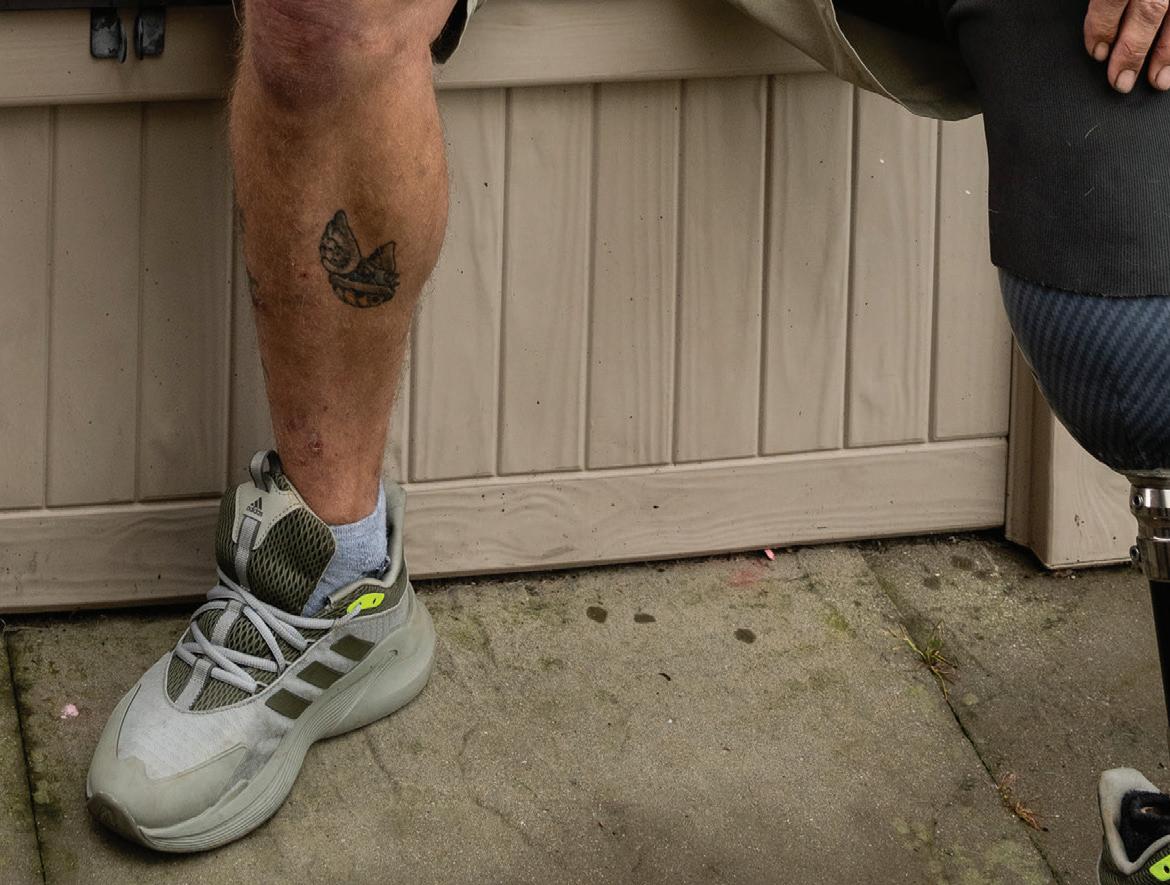



Winter can be an expensive time of year. Increased heating bills and extra spending on gifts for the festive period are two of the main culprits for draining your wallet, but there are other costs too. We investigate the most effective ways to cut back
It happens every year – more of us spend time at home, the heating goes on, then we’re told energy prices are rocketing. Many of us need to buy extra clothing and food to keep warm, not to mention the panic buying that can happen when we face a cold snap. Plus we need to add on what Scope has called the Disability Price Tag – disabled households need an extra £1,095 each month on average, just to have the same standard of living as non-disabled households.
You may feel helpless in the face of extra costs, but there are things you can do to reduce their impact on your finances. Making sure you’re receiving all the benefits you’re entitled to is a good first step to help maximise your income. Visit entitledto.co.uk to use their benefits calculator – you can input your personal information to find out how much support you could be getting, and discover whether you’re missing out on any state benefits.

A quick check on gov.uk will tell you what you need to know about benefits like Pension Credit, Universal Credit and PIP, or you can head to your devolved parliament’s website for nation-specific information – changes earlier this year in Scotland, for example, mean Pension Age Disability Payment has replaced Attendance Allowance, and Carer’s Allowance has now become Carer Support Payment.
There’s winter-specific support as well, including the Winter Fuel Payment for older people, and the Cold Weather Payment. The latter is paid to people on low incomes in England, Wales and Northern Ireland when the average temperature in your area goes below zero over seven consecutive days. In Scotland, you might get an annual Winter Heating Payment of £59.75 if you’re receiving certain benefits, which is paid regardless of weather conditions. If all of this sounds daunting and you’re not a fan of paperwork or online form-filling, Citizens Advice, Scope’s helpline, and your local council’s welfare rights service can all help explain benefits clearly and simply. Some local authorities even offer help with filling out applications, like Advice Works for people living in Renfrewshire.
While we’re on the subject of utility bills, signing up to your electricity, gas and water supplier’s Priority Services Register is a great idea. This means that, in the event of a power cut, burst
Adding up what you spend on impulse buys might shock you
water main or gas interruption, suppliers can look after customers who have extra communication, access or safety needs. To find out if you meet the criteria to register – such as using medical equipment that’s reliant on electricity or water, being disabled, or having children under five in your household – visit thepsr.co.uk.
With many of us spending more time indoors, it’s a good time to carry out a personal budget health check and make sure your money is going as far as it can. That means looking at all your income (from benefits and wages to savings interest) and outgoings (even down to haircuts, birthday gifts and vehicle servicing).
From here, you should be able to see where you could reduce your spending. The classic suggestion is to use a price comparison website to save on utility costs, insurances and regular bills. But there are other things you can do as well – like cancelling unused app subscriptions, switching to buying
supermarket own brands, avoiding impulse buys (waiting a set time, like 48 hours, before making that tempting purchase), and cutting down on grabbing coffees when out and about.
Although these changes may seem a little joyless (why shouldn’t you enjoy a takeaway hot drink at this time of year?), adding up everything you spend on these buys might shock you. And it can be fun to think of alternatives. Taking a hot drink out in a flask has a homely retro vibe, or you can gamify your shopping experience – what’s the cheapest you can find the item, using price comparison sites, discount codes or deal stacking (combining discount codes, cashback offers and retailer points schemes)?
This time of year often sees a rise in scams, with criminals trying to con people out of their money and personal information. With more of us shopping online, be wary of fake websites and delivery scams requesting address details or extra postage fees – often via official-looking text messages. You might also encounter phishing texts and emails pretending to be from HMRC, your bank, or family members.
Get wise to fraud and cybercrime by visiting actionfraud.police.uk. You can support vulnerable friends and family by asking them to show you any messages they receive on their phone or tablet before they reply to them, to reduce the risk of them becoming a victim of unscrupulous criminals. Remember that purchasing items on a credit card or through PayPal gives you extra protection if things go wrong. Contact the police and your bank if you think you’ve been a victim of a scam. Fraud can happen to anyone, so stay alert.
When so many people are feeling the pinch at this time of year, whether it’s money saving tips or avoiding fraud, or help via benefits to protecting your loved ones, it pays to be money wise in winter – and every season.
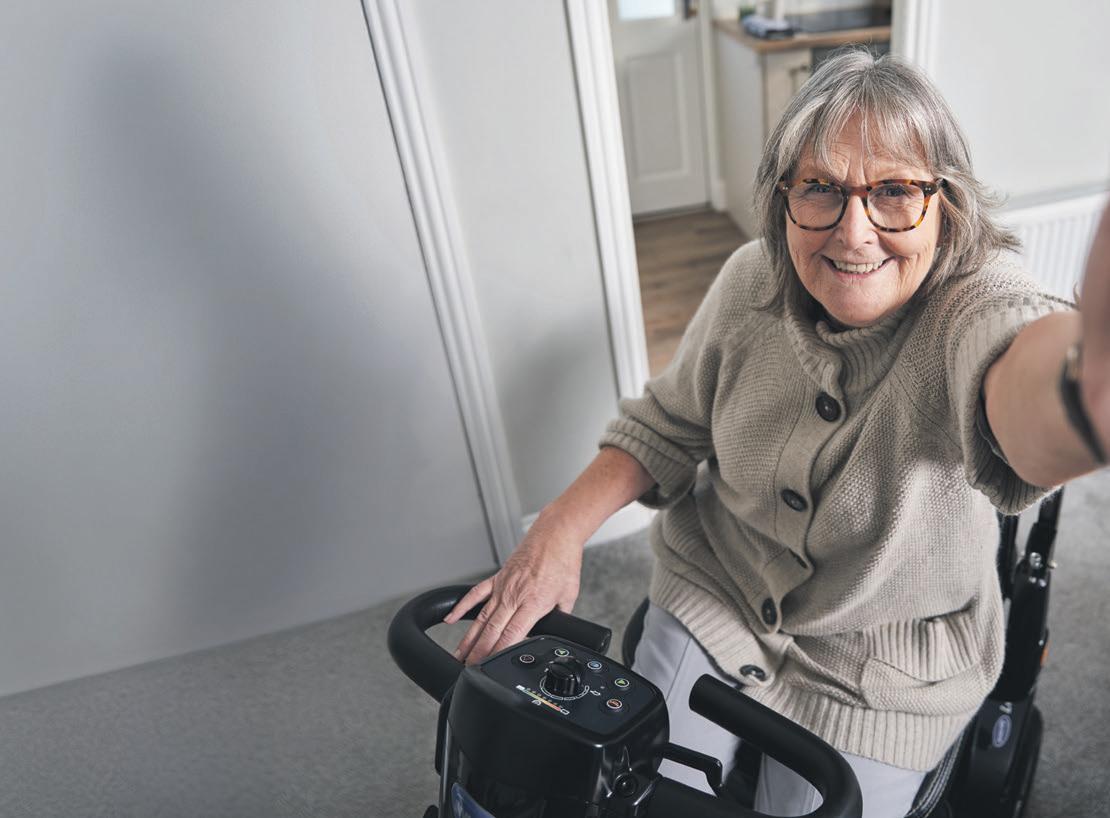










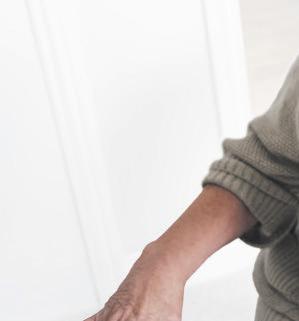



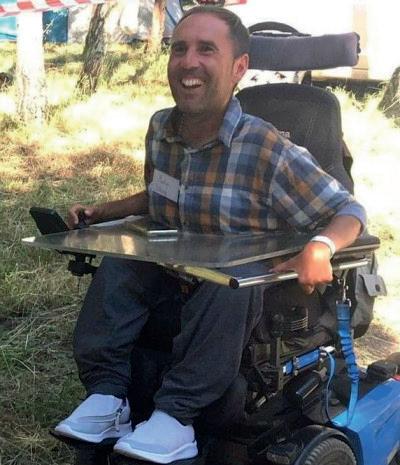

Striking looks mark out the Jaecoo J7 in a hotly contested sector, but does the drive match the style? Our motoring expert checks out the brand’s latest model

Unlike many cars that claim to be SUVs, the Jaecoo 7 delivers on its promise with a raised driving position that affords good forward vision. It’s not quite so good when reversing, but the 7 comes with rear parking sensors to counter this. The height of the driver’s seat also makes it very easy to get in and out of the Jaecoo, while electric adjustment is standard on all models. The driver is also treated to a clear digital main dash display and large central infotainment screen.
How the 7’s cabin appears is partly down to which trim you choose, though the hybrid model
only comes in one generous specification. The petrol version has two trim levels, and this engine option also means you get a surprisingly large gear selector for the automatic transmission. The hybrid model has a much simpler stalk to choose gear on the right hand side of the steering column.
Space in the back of the Jaecoo is good, and the boot has a decent capacity in the front-drive petrol model, plus the tailgate is powered to save you reaching up to close it. Opt for the four-wheel drive petrol or hybrid version, and the boot is quite a bit more cramped.


The Jaecoo 7 is available through the Motability scheme. The Deluxe petrol model requires an advance payment of £2,999 and uses the full weekly amount of your PIP’s total mobility allowance. In the Luxury trim, the 1.6 petrol automatic requires an advance payment of £3,999, while the 1.5 petrol-electric plug-in hybrid requires an advance payment of £5,899. These options also use the full weekly amount of your PIP’s total mobility allowance. Find out more at motability.co.uk

The Deluxe model is the starting point for the Jaecoo 7 range and comes with 19 inch alloy wheels, automatic headlights, rain-sensing wipers, powered tailgate, parking sensors front and back, parking camera, and a panoramic sunroof. You also get heated and electrically adjusted front seats, faux leather upholstery, climate control, and a 13.2 inch infotainment screen. The Luxury model adds four-wheel drive for the petrol model and is the standard trim for the hybrid version. They gain a larger 14.8 inch infotainment screen, head-up driver’s display, heated and ventilated front seats plus heated outer rear seats, and a heated steering wheel.

Each Jaecoo 7 model offers a subtly different driving experience as the 1.6 litre petrol models come with front- or four-wheel drive, depending on which trim you choose. The hybrid model has a 1.5 litre petrol engine and an EV driving range of up to 56 miles. So long as you can stretch to the noticeably higher initial payment for the hybrid car, it’s the one we’d recommend.
This has to come with the caveat that the Jaecoo 7 is far from the best car in its class to drive, regardless of which version you pick. It copes well enough for low-speed town driving but, as soon as the pace picks up, the suspension fails to absorb most bumps, yet flops into corners. This is further undermined by steering that
has an almost total absence of feel. While we don’t expect sports car reactions in an SUV, a modicum of interaction is needed to gauge how much steering lock is required as you drive through a bend – yet the Jaecoo falls short here.
The automatic gearbox is smooth in operation, but the selector for the hybrid model doesn’t always select the gear you want, which is an irritation.
There’s much to recommend the Jaecoo 7 – equipment, cabin space, comfort – but there are also too many driving flaws compared to its rivals.




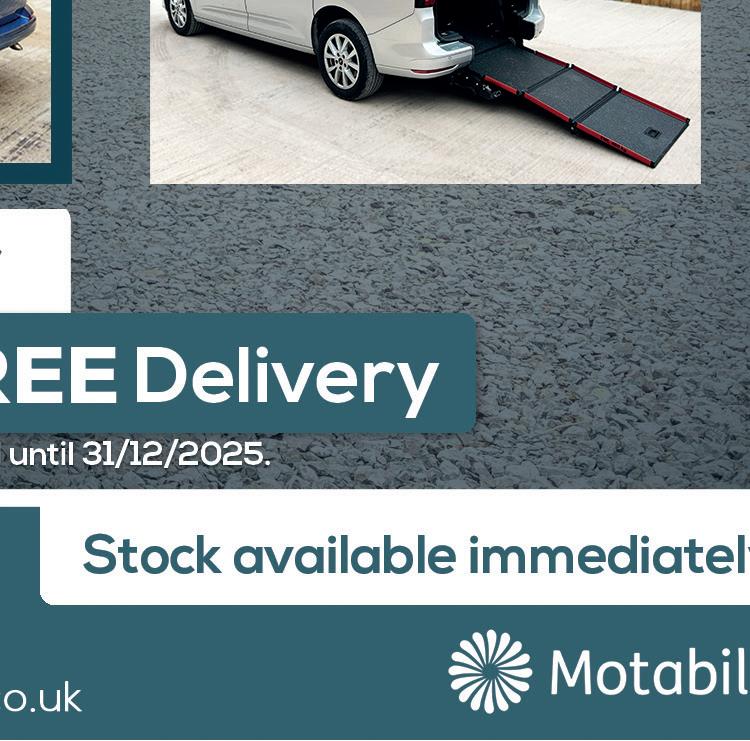

Jane Hatton
Jane is the founder of Evenbreak, a social enterprise run by and for disabled people, with a specialist job board and a career hive.
Send your questions to editor@dcpublishing.co.uk

QI really want to work, but because of my disability (ME/ CFS) I’m unable to travel to a workplace. I’d be so tired by the time I battled through transport to get there, I would be unable to perform. I’d love to work from home, but there are so few employers that allow this. I want to get off benefits and be independent, but how do I find a job I can do from home?
ASince the pandemic, when most people were forced to work from home, it has become a popular choice for many disabled and non-disabled people. Avoiding the rush-hour commute, spending more time with family, improved focus and comfort are attractive to many. For some disabled people, it can also be a means to be able to work which might otherwise not be possible. We find that many permanent,
full-time or part-time roles can be done from home, even if they’re not advertised as such. When searching on job boards, it’s a good idea to put terms like ‘homeworking’ or ‘remote working’ into search fields, as these phrases may appear within the body of an advert, rather than as one of the search filters.
If you see a role you like the look of and have the required skills for, and the role could feasibly be carried out remotely, it’s always worth asking the employer if homeworking could
Many permanent, full-time and parttime roles can be done from home, even if they’re not advertised as such
Our careers expert Jane Hatton, founder of disability employment service Evenbreak, answers a reader’s question
be considered. Many employers are open to flexible arrangements and don’t always explicitly state that working from home is an option. In some circumstances, working from home may be offered as a reasonable adjustment to accommodate access needs.
Remember that, under the Equality Act 2010, employers still have to offer workplace adjustments to employees who work from home, so if you need flexible hours, ergonomic seating or assistive technology in your home office space, make sure you make this known to the employer.
And, if you’re working from home (or from a workplace), you can also apply for Access to Work funding, which is a grant to help you get or stay in work if you have a physical or mental health condition or disability. Access to Work can help pay for things like specialist equipment, assistive software, or support workers, like a job coach.
Good luck with your search!
We take a look at how home education can offer a viable alternative for children who struggle in ‘normal’ school environments
For many disabled and neurodivergent children, school is not a happy place. From inaccessible buildings to the highly stimulating environment of a busy classroom, traditional education just doesn’t suit some kids. Hugh Viney, founder and CEO of Minerva Virtual Academy (MVA), told us: “Our current education system is built for a world that no longer exists or works for many pupils. Traditional classrooms are often rigid, sensory-heavy, and designed around a one-size-fits-all approach.” For neurodivergent children in particular, school can lead to disengagement, anxiety, and underachievement.
It’s easy to see why home education is on the rise. The Autumn 2024/25 census found 111,700 children in England were registered as home educated – up from 92,900 the previous year. Additional support needs are among the top reasons why many parent carers deregister their children. Lydia Scaltsas, founder and director of private tutoring service LS Tuition, explains: “We’ve seen a significant rise in families choosing home or flexi-education. Around 72% of our student body have a diagnosed or undiagnosed additional support need, and many have previously struggled to thrive in traditional school environments.”
Home education takes many forms.


Confidence is the most consistent and transformative outcome we see Hugh Viney, MVA
Some parents prefer a structured, routine-led approach, others unschool – letting their children take the lead –while some use tuition services like LS Tuition, which supports primary-aged pupils in Scotland, or MVA, an awardwinning, DfE-accredited online school for 11 to 18 year olds.
More parents are turning to home education because they feel it’s a better choice for their child. Being able to offer your child a holistic learning experience in an environment that feels safe and comfortable to them, and supporting them to learn based on their interests and at their pace, can have truly powerful results.
And, far from limiting social contact, many families find that home education
expands it. Active home ed community groups offer meetups, museum trips, shared resources, and the chance to spend more time in the wider world.
But it’s not without challenges. Home education demands commitment. Many parents find they need to reduce their hours or stop work altogether. Costs such as museum visits, exam fees, and private tutoring can also add up.
There are legal requirements too. In England, you must provide full-time education for your child from the age of five, and councils can make an ‘informal enquiry’ to check what you’re offering is suitable. But there’s no need to follow the National Curriculum, which means that home education looks different for every family.
The results can be remarkable. “Confidence is the most consistent and transformative outcome we see,” says Hugh. Lydia agrees: “With the right support, children who were once labelled as disengaged or ‘behind’ often rediscover their curiosity and begin to enjoy learning again.”



SignLive (Soon to be Convo) makes your services accessible to Deaf BSL users – instantly. With a simple QR code, customers can connect to a qualified BSL interpreter in seconds.



We enable businesses and organisations to connect with Deaf customers and employees - instantly, clearly and without hassle.
Together, we’re building a more inclusive UK.
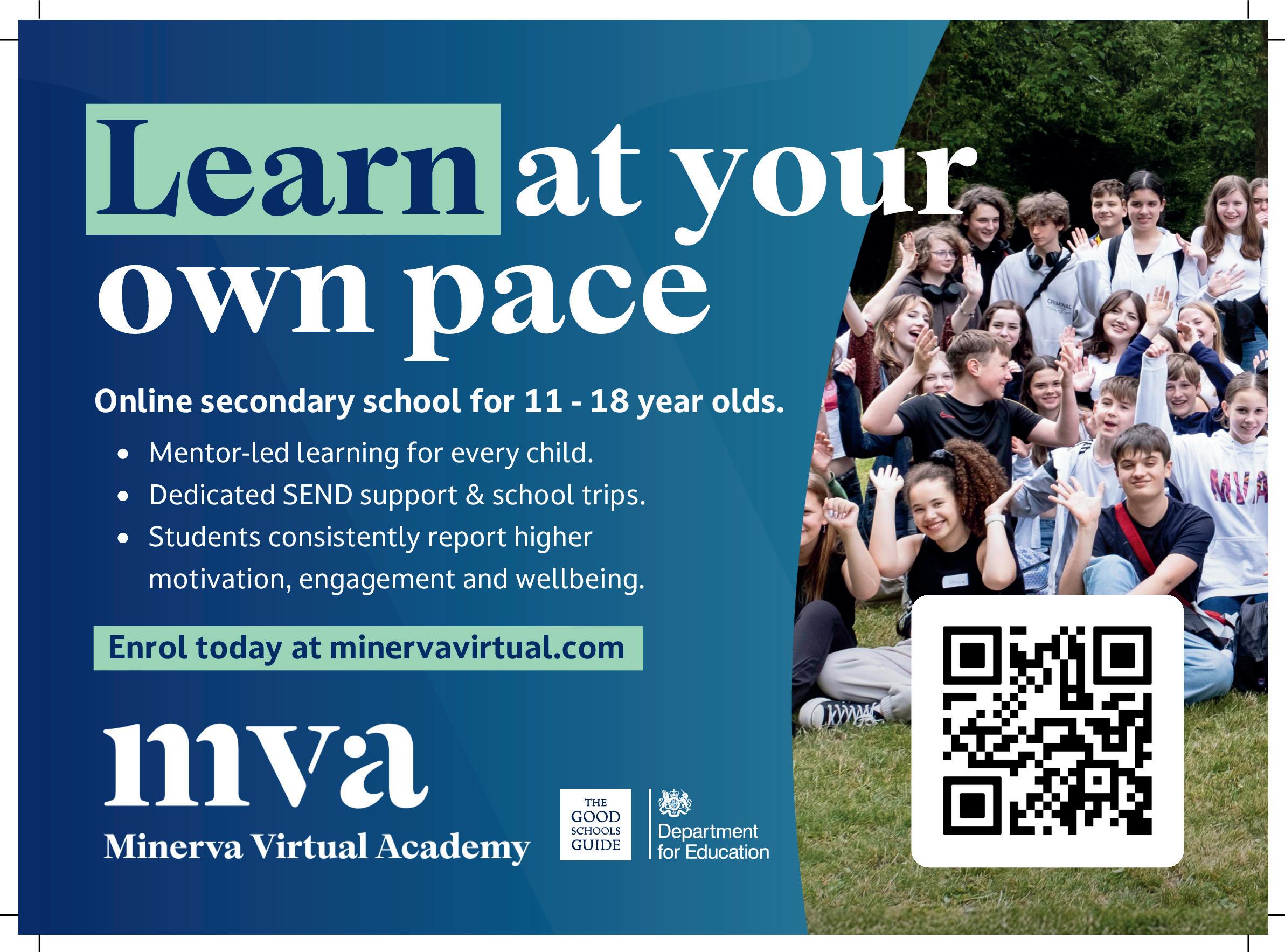








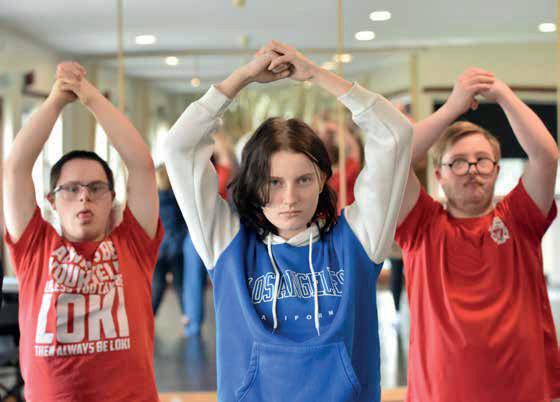


Derwen College is a specialist day and residential college for young adults (aged 16–25) with special educational needs and disabilities (SEND) to continue their education. Through a variety of taught and practical activities, students gain:







Our pathways and programmes are tailored to meet individual student needs in preparation for adulthood.









Book now for our 2026 dates as spaces fill up fast! For more information, please contact our Admissions Team: admissions@derwen.ac.uk

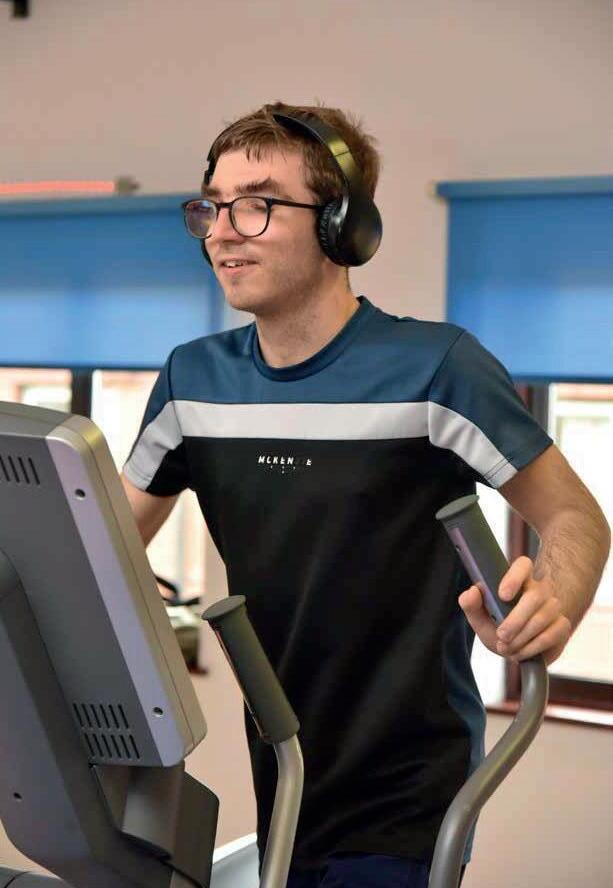


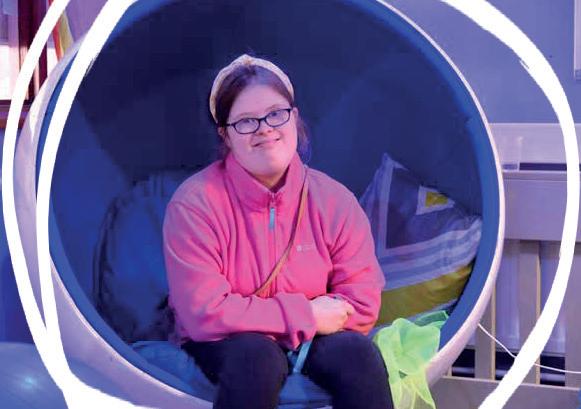



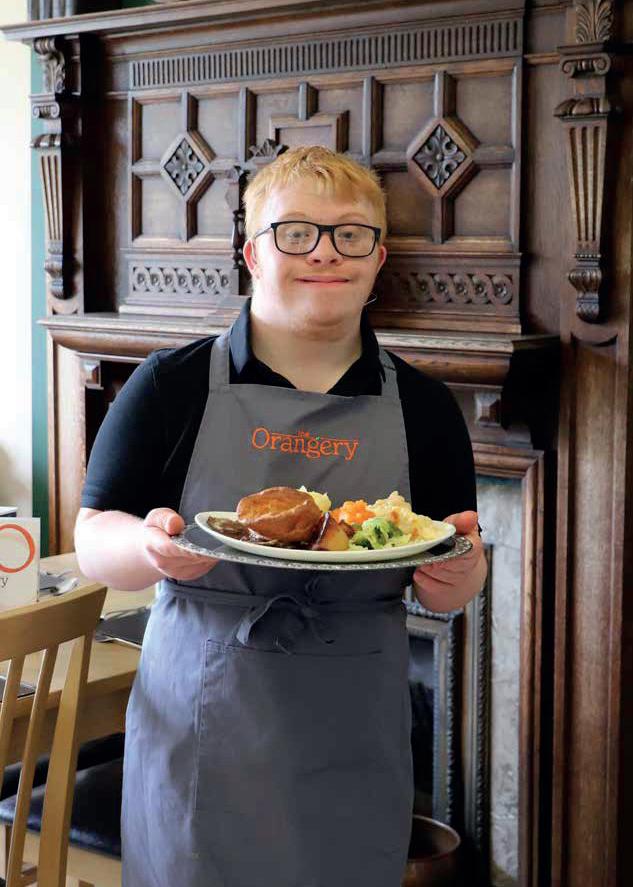




Barely a generation ago, finding and keeping a job as a disabled person was challenging. How are things changing?
At 21, Maisy GallagherHorwood has landed a job with Oxfordshire County Council as its special educational needs and disabilities (SEND) media support officer for supported internships. Maisy has cerebral palsy and uses a wheelchair, and was offered the year-long contract after proving herself at the council during a supported internship programme, which is for people aged 16 to 25 who have an EHCP.
SO MANY OPPORTUNITIES
Maisy explains: “There are so many opportunities for me, I can’t thank Oxfordshire County Council enough. I
can even show off my creative side, developing a comic strip newsletter for young people, designed to be accessible to children and young people with SEND.” Maisy plans to visit a local college to interview students participating in supported internships: “I’ll be sharing my own experiences, and I aim to gather ideas and information about ways to make workplaces more accessible and inclusive.”
Simply accessing an opportunity like this may seem difficult, but there are suitable roles out there, and employers are legally obligated to accommodate your requests for reasonable adjustments both at interview stage – so you’re competing on a level playing field with other candidates – and once you’re in employment. This might mean securing a BSL interpreter for your interview, requesting step-free access to the job location, or asking for a height-adjustable desk and chair while in the workplace.
For Maisy, reasonable adjustments have meant access to an adjustable desk, so she can work in a reclined position to avoid back pain, and a carefully planned work pattern that includes regular short breaks, which helps her to concentrate on tasks more effectively.
Before you even reach interview stage, you can get support from job coaches and organisations who support disabled people into work. You might need help with finding volunteering opportunities to give you more experience prior to employment, advice on polishing up your CV, or coaching on how to answer interview questions.
James is in his early thirties. After experiencing bullying from his boss in a high street retail role, James had been out of work for just over a year when he was referred to Into Work. This charity supports young people and adults in Edinburgh and the Lothians who are disabled, neurodivergent or who have longterm health conditions, by providing a free, personalised supported employment service to help people secure fair, sustainable employment.
If I can get more people thinking about disability in a more positive way by showcasing what we can contribute, then I’ll fly the flag Maisy
James took his previous employer to tribunal and won the case, but the experience had a negative effect on his self-esteem and confidence. James wants to work with older people, so Into Work is supporting him towards a volunteering opportunity so he can gain skills and experience in this area. He’s applied for a volunteer role with the help of a Volunteer Buddy, and he hopes to build skills and confidence to move toward his goal of securing meaningful, paid employment.
The government-funded scheme Access to Work is helping to boost access to employment. It can provide funding towards communication support during interviews for people with learning or sensory disabilities.
Once you’re in work, Access to Work funding can be used to pay for specialist equipment and assistive software, support workers (like a BSL interpreter or travel buddy), the costs of travelling to work if you can’t use public transport (or adaptations to your vehicle so you can get to work), and physical changes to your workplace.
Maisy has used Access to Work to obtain regular support from job coaches within the council’s supported employment team, which has boosted her confidence and enabled her abilities to grow.
One thing that’s having a positive impact on disabled people’s access to the workplace is the rise of flexible
working and working from home.
From their first day of employment, employees now have the legal right to request flexible working. So, even if a job isn’t advertised as being a work from home position, it still could be – you can request hybrid working arrangements (working from both the home and workplace), to fully work from home, or a change to work schedules, such as compressed hours, staggered hours, job sharing or part-time hours.
Employers must agree to an employee’s flexible working request unless there’s a genuine business reason not to, and research has shown flexible working policies benefit employees and employers, through improved wellbeing, increased productivity, and reduced sickness and stress absences.
It would be naive to say that access to employment is getting easier for disabled people. Figures from the Office for National Statistics show almost one in four working age people are now classed as disabled, but those figures may be skewed by more employed people being diagnosed with long-term physical and mental health conditions, rather than more disabled people entering the workforce.
All the same, thanks to accessible recruitment programs, increased awareness of the capabilities of disabled people, changing technology, and more flexible approaches to what employment should look like, some disabled people are finding the barriers to employment are breaking down.
As Maisy herself says: “If I can get people thinking about disability and special educational needs in a more positive way by showcasing what we can contribute to employers and society in general, then I will fly the flag and blow the trumpet until people listen and act.”


At only 21, Ruby Bishop is one of the brightest stars in UK wheelchair tennis. And she’s aiming even higher, with her campaign to tackle discrimination and improve access to PE lessons at schools across the country
Imagine having to sit out of lessons at school and watch your classmates have fun, while you’re left to your own devices. Sounds depressing, right?
But that’s the case for the disabled young people who find themselves excluded from sport at school. “I never did a sports day or PE lesson,” explains Ruby, who has cerebral palsy. “I just sat in the SEND department and made PowerPoints on Paralympians.”
Ruby’s school blamed health and safety – they were worried she might run over someone’s foot in her wheelchair, even though she was already playing at a high level in both wheelchair tennis and basketball. And it wasn’t just sport that she struggled to enjoy at school. “There were buildings that weren’t accessible,” she remembers. “There were so many things that added up to make your day harder than somebody else’s.”
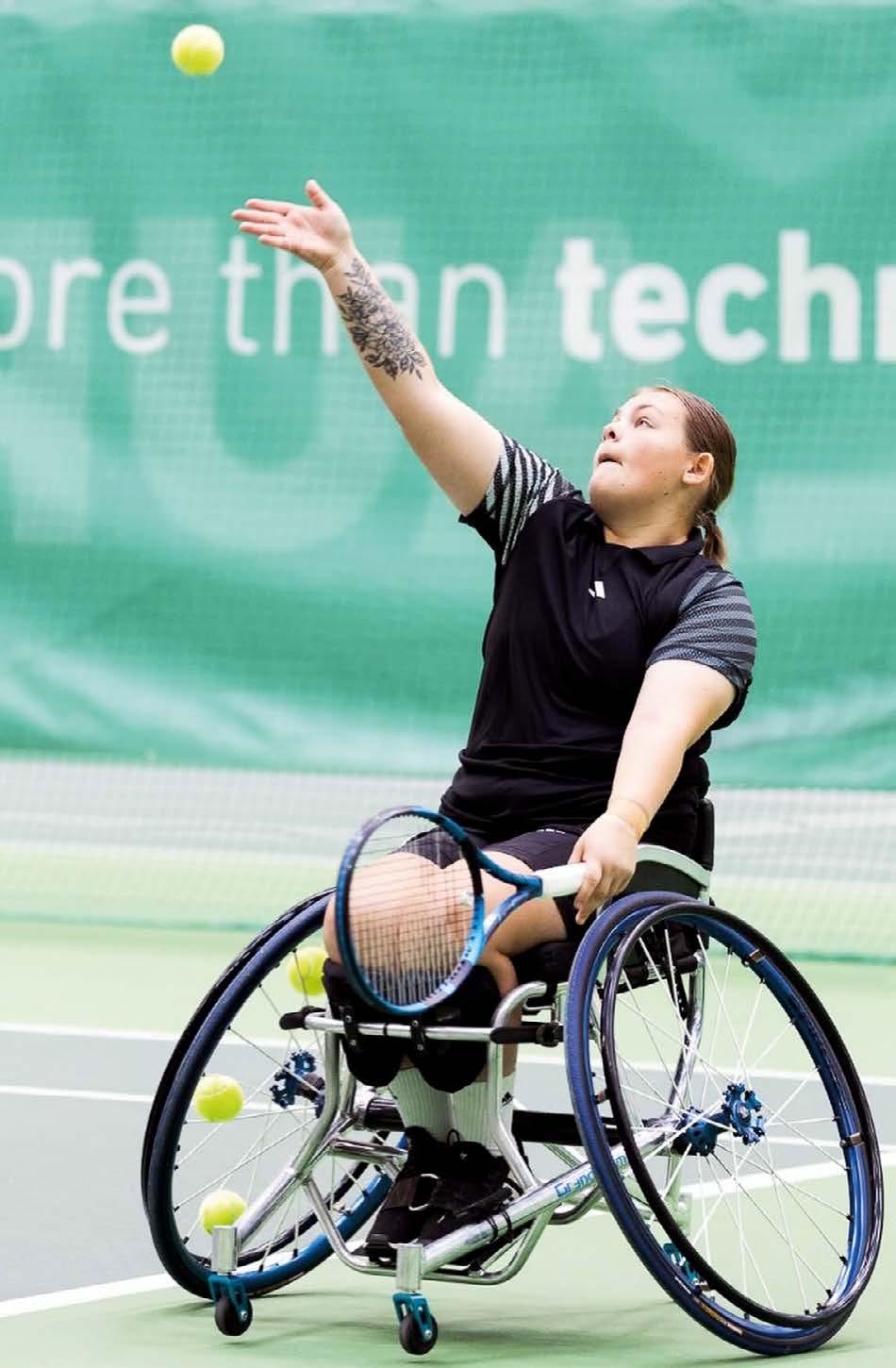
Ruby was lucky – at 14, she found wheelchair basketball through a summer school run by Norwich hospital’s physio team. The following year, the same scheme introduced her to wheelchair tennis, which changed her life. Within a few years, she was rubbing shoulders with Paralympians, and reached a career high of third in the world for girls’ wheelchair tennis (she’s currently ranked number four in UK singles).
She’s keen to ensure others don’t experience what she did at school, so Ruby launched her campaign once she left high school in 2020. She visits schools to spread the word about making PE lessons accessible, smiling as she says: “To turn something that was such a challenge for me into something so good is great.”
By sharing her lived experience and encouraging mainstream schools to try out accessible sports like boccia and sitting
Sport gave me a sense of purpose when I was very lost in school
volleyball, Ruby is opening people’s minds to accessibility. “A lot of teachers are scared they’ll say or do the wrong thing,” she feels. “That can result in them doing nothing.” She’s been surprised by the number of disabled people who’ve had similar experiences in school, and says: “That’s why it’s so important to have that conversation. The response has been amazing so far.”
Ruby’s aim is to get a sports wheelchair into every school’s PE department across the UK, for any student to use. “I think it should be standard equipment,” she states. She’s so passionate about it because of the positive benefits she’s experienced: “Sport gave me a sense of purpose when I was very lost in school. I didn’t know what I was going to do, but I found sport, and I pursued it.”
Of course, not every disabled child will (or wants to) become a Paralympian. “That’s a common assumption,” Ruby chuckles. “Just being able to exercise can really help your mental health and confidence. It’s so much more than just playing the match.”
FOR MORE INFORMATION
Learn more about Ruby’s campaign at instagram.com/r.ubybishop











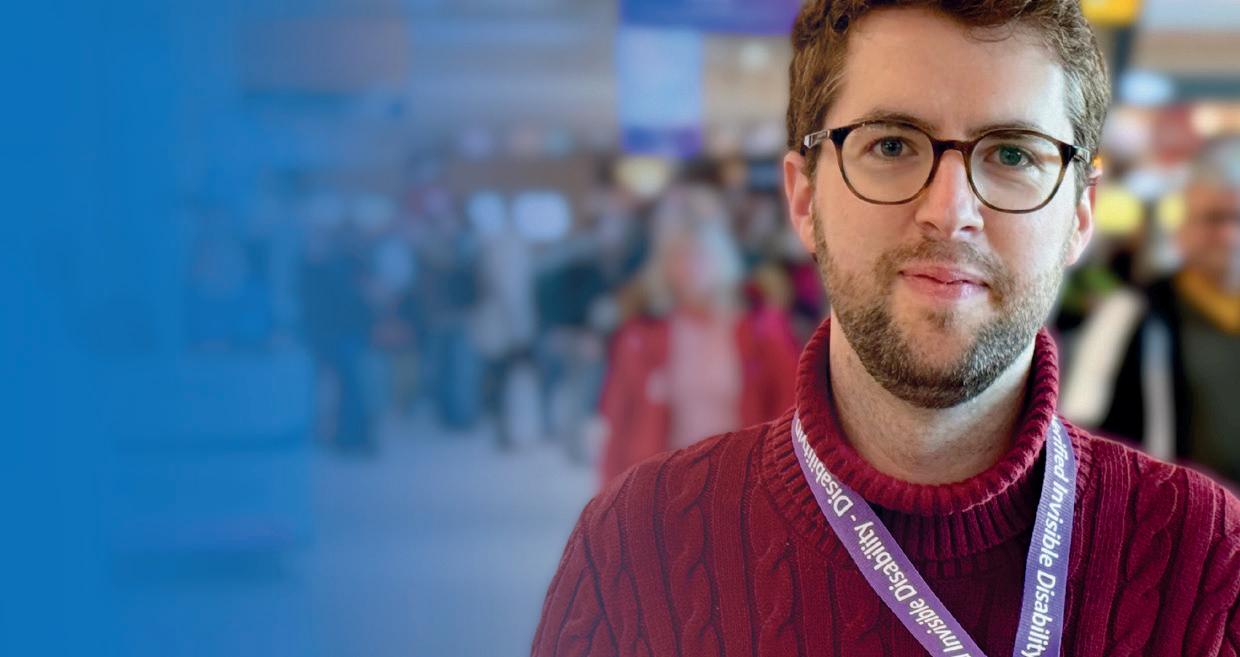








Exclusively for disabled individuals and carers


Easy to carry - fits in your wallet
Accepted at 500+ locations

Access hundreds of concessions on days out and shopping




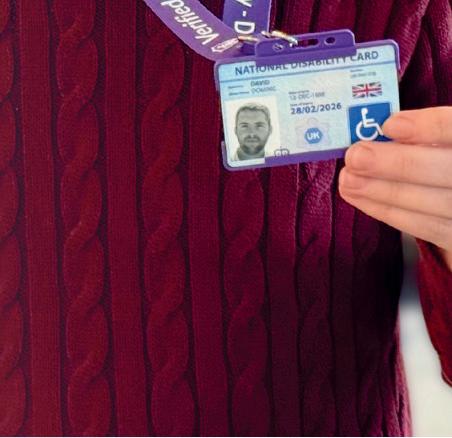



Advanced security features Fast delivery


Emergency contact QR code Premium lanyards available exclusively to card holders
Accepted by leading brands













